Business Resource Centers: Entrepreneurial Development
Film Commission
International Trade and Diplomacy
Procurement Technical Assistance Centers (PTAC)
State Science Advisor
Utah Recruitment Initiative
Governor’s
CONTENTS Letter from the Executive Director . . . . . . . . . . . . . . . . . . . . . . . . . . . . . . . . . . . . . . . . . . . .2 Companies from Around the World are Taking “Stock” in Utah . . . . . . . . . . . . . . . . . . . .3 Governor’s Office of Economic Development Programs . . . . . . . . . . . . . . . . . . . . . . . . . .5 Targeted Economic Clusters . . . . . . . . . . . . . . . . . . . . . . . . . . . . . . . . . . . . . . . . . . . . . . .6 Business and Technology Parks . . . . . . . . . . . . . . . . . . . . . . . . . . . . . . . . . . . . . . . . . . . .12 Centers of Excellence (COE) . . . . . . . . . . . . . . . . . . . . . . . . . . . . . . . . . . . . . . . . . . . . . .15 Corporate Recruitment and Incentives . . . . . . . . . . . . . . . . . . . . . . . . . . . . . . . . . . . . .18
. . . . . . . . . . . . . . . . . . . . .26
. . . . . . . . . . . . . . . . . . . . . . . . . . . . . . . . . . . . . . . . . . . . . . . . . . . . . . .27
. . . . . . . . . . . . . . . . . . . . . . . . . . . . . . . . . . . . . . . .29
. . . . . . . . . . . . . . . . . . . . . . . . . . .31
Development . . . . . . . . . . . . . . . . . . . . . . . . . . . . . . . . . . . . . . . . . . . . . . . . . . . . . .33
Rural
. . . . . . . . . . . . . . . . . . . . . . . . . . . . . . . . . . . . . . . . . . . . . . . . . . . .35
Office of Tourism . . . . . . . . . . . . . . . . . . . . . . . . . . . . . . . . . . . . . . . . . . . . . . . . . .37
Utah
. . . . . . . . . . . . . . . . . . . . . . . . . . . . . . . . . . . . . . . . . . . . . . .40
Office of Economic Development Partners . . . . . . . . . . . . . . . . . . . . . . . . . .41 Economic Development Corporation of Utah (EDCUtah) . . . . . . . . . . . . . . . . . . . . .42
Fund of Funds . . . . . . . . . . . . . . . . . . . . . . . . . . . . . . . . . . . . . . . . . . . . . . . . . . . . .44
Science Technology and Research Initiative (USTAR) . . . . . . . . . . . . . . . . . . . . .45
Sports Commission . . . . . . . . . . . . . . . . . . . . . . . . . . . . . . . . . . . . . . . . . . . . . . . . .48 Small Business Development Centers (SBDC) . . . . . . . . . . . . . . . . . . . . . . . . . . . . . . .51 Manufacturing Extension Partnership . . . . . . . . . . . . . . . . . . . . . . . . . . . . . . . . . . . . . .54 Utah Defense Alliance . . . . . . . . . . . . . . . . . . . . . . . . . . . . . . . . . . . . . . . . . . . . . . . . . . .57 World Trade Center . . . . . . . . . . . . . . . . . . . . . . . . . . . . . . . . . . . . . . . . . . . . . . . . . . . . .59 GOED Organizational Chart . . . . . . . . . . . . . . . . . . . . . . . . . . . . . . . . . . . . . . . . . . . . . . . .60
Utah
Utah
Utah
Governor’s Office of Economic Development
JASON P. PERRY Executive Director
State of Utah
JON M. HUNTSMAN, JR. Governor
GARY R. HEBERT Lieutenant Governor
October 1, 2008
Dear Legislator and Business Leader:
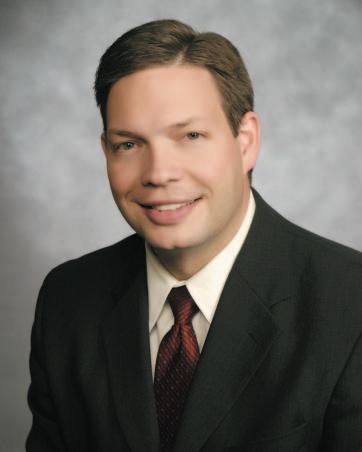
It is a pleasure to present this Annual Report for FY2000-08. Utah continues to maintain a strong economy and low unemployment despite national trends. Utah also has been honored with accolades from leading business media and rating organizations. Forbes Magazine has for the second year in a row ranked Utah as a “Best Place” in the nation to do business. This year the editor of Forbes noted Utah continues to improve in its “basic business fundamentals.”
The Huntsman Administration and the Legislature have spent wisely on education, transportation and worked hard to give citizens and businesses significant tax relief. Establishing a safe and stable economy in the midst of turmoil is no small task. While we recognize government does not create jobs, business does; it is clear that government can help to create a good business climate where innovation and entrepreneurship can flourish.
This past year has been good for Utah. Companies such as Procter & Gamble, Oracle, Disney and Goldman Sachs have all chosen Utah as a great place to grow. Utah workers and families will benefit through great wages and corporate investments in their communities. Our Utah citizens are truly able to enjoy “Life Elevated.”
The following report helps to show why “Utah is a hot stock” on the world stage and outlines some of the economic development efforts and programs that have created an environment where business can grow.
The Governor’s Office of Economic Development and its staff look forward to the coming year, its challenges and opportunities for continued success in serving the citizens of Utah.
Sincerely,
Jason P. Perry Executive Director
Governor’s Office of Economic Development
Governor’s Office of Economic Development • Annual Report 2008 2
South State Street, Fifth Floor • Salt Lake City, Utah 84111 • (801) 538-8700 • facsimile (801) 538-8888 • www.goed.utah.gov
324
COMPANIES FROM AROUND THE WORLD ARE TAKING “STOCK” IN UTAH
A reporter asked Governor Jon Huntsman about the buzz surrounding Utah in the world market place. Governor Huntsman noted, “Everything has its time to be ‘hot’ and this is Utah’s time to be hot.”
Governor Huntsman recognized that with the proper tools, people and leadership the State was prepared to move into the upper ranks of the “Best Places for Business.”
Over the previous decades Utah has been trying to share its value as a great business destination with varying levels of success. However, in 2004 Governor Huntsman working with the Utah Legislature created the Governor’s Office of Economic Development (GOED). Now Utah’s “Stock” has become a “Hot Commodity.”
Is it the quality of life? The great vistas, the four seasons that affords world renowned recreation and outdoor activity, is it the productive workforce? Utah workers have long been considered one of the most productive and well educated populations in the country. Boasting the youngest workforce in America, at an average age of 28 years old, the State has several decades of power house success ahead of it.
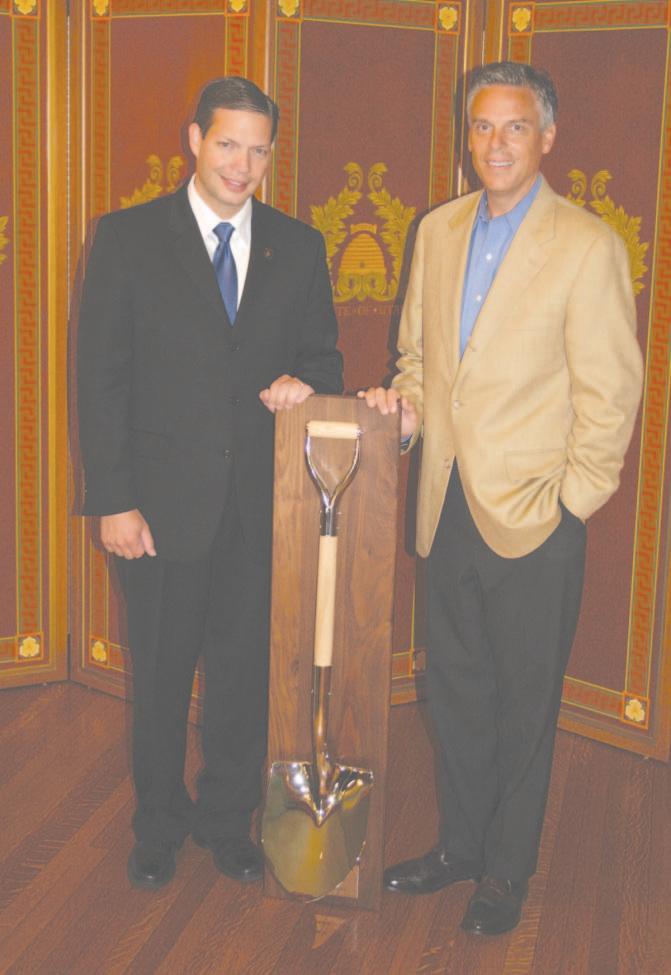
Governor Jon Huntsman and Jason Perry, Executive Director of GOED, with the Silver Shovel award for “Best Small State in Economic Development.” Utah has won this national award two years in a row.
Recently, Utah was recognized by The Pew Center on the States as the “Best Managed State in the Nation.” A fiscally conservative legislature has worked hard with the Governor over the years to establish a well managed and progressive governmental platform that provides stability and predictability in spending, tax policy and a business friendly climate. If there is anything business leaders around the world crave, it is a safe, stable and predictable place to conduct business. Utah is that place.
GOED has targeted industries in specific economic clusters that show substantial promise for economic development and Utah leadership on the world stage. Those Targeted Economic Clusters are:
•Av iation and Aerospace
– Advanced Composites
•Defense and Homeland Security
• Energy & Natural Resources
• Financial Services
• Life Sciences
– Personalized Medicine
– Medical Products
•
•Outdoor Products & Recreation
•Software Development & Information Technology
• Emerging Industries include:
– Advanced Manufacturing
– Logistics & Distribution
– Nanotechnology
Governor’s Office of Economic Development
Annual Report 2008 3
COMPANIES FROM AROUND THE WORLD ARE TAKING “STOCK” IN UTAH
In all of the growth and activity of the past year, Utah’s rural communities have not gone unnoticed. A great deal of effort has been put into the Rural Fast Track and Rural Broadband Service Fund. The Fast Track program was designed to assist ongoing businesses in Utah’s smallest communities. When a company based in Escalante can add a few employees or a new line of business it has a significant impact on the local economy and economic development of the whole community. With a limited number of funds, the Rural Fast Track Program, in its first year, has extended offers of assistance to 18 rural companies in cities across Utah. Milford, Gunnison, Escalante, Price, Roosevelt, Helper, Huntington and Kanab are a few of the communities that have benefited from the program.
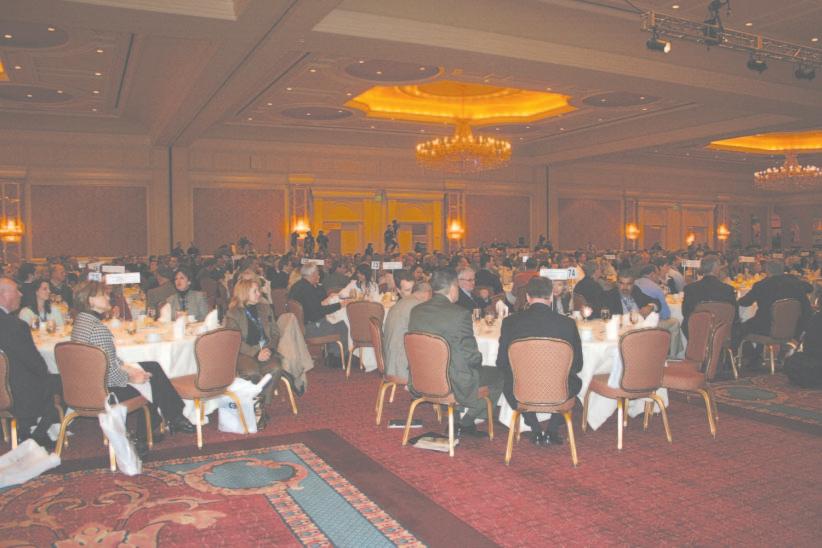
Businesses such as Applied Composite Technology, in Sanpete County, manufactures prosthetics from advanced composites. It can now add employees and a new product line. B.W. Bowmar Company, in Garfield County, is a machine shop that can grow because of the Rural Fast Track Program. TC Engineering, in Kane County, will be adding employees at good salaries to its engineering staff. Many administrations and Legislatures of the past have wanted to do something for rural business. Now it is being accomplished and all of the various businesses and communities that have received assistance are showing positive signs of strength.
Like Fast Track, the Rural Broadband Service Fund was created to provide the “circulatory system” of commerce in Utah’s rural communities. High speed internet has become the life blood of many businesses today. Without high speed connections in our rural communities they cannot even be considered as possible locations for many business ventures. Although the one-time funding provided by the Legislature was only $1 million, 44 new broadband systems have been added to communities in Beaver, Cache, Carbon Iron, Morgan, and Sevier counties to mention a few. GOED and the Governor’s Office hope the Legislature will continue funding these rural programs.
Big or small, urban or rural, Utah continues to grow and strengthen its economy. For the second year in a row Forbes has ranked Utah as a “Best State for Business.” The Beacon Hill Institute in Massachusetts recognized Utah as the Number 1 “Most Competitive State for Business,” and the Milken Institute in its State Technology and Science Index called Utah, “#1 in Technology Concentration and Dynamism.”
Like any other stock on the rise, it is what others say about you after the fundamentals are in place that makes it “Hot.” The Governor’s Office of Economic Development will continue to build on the strengths Utah now has in place. With continued legislative support and the Governor’s leadership and vision, a dynamic business climate which is safe and secure will continue. GOED is committed to the hard work necessary to ensure this future and is pleased to report on its successful past year.
Governor’s Office of Economic Development • Annual Report 2008 4
Governor’s Economic Summit 2008 at the Salt Lake City Grand America Hotel.
PROGRAMS
Governor’s Office of Economic Development • Annual Report 2008 5
TARGETED ECONOMIC CLUSTERS
Clusters are groups of related businesses and organizati ons within industry whose collective excellence, collaboration and knowledge base provide a sustainable competitive advantage.
Strong Clusters translate directly into tangible benefits for Utah’s businesses, citizens and educational institutions. In Clusters, businesses have shared access to suppliers, services, resources, technology and workforce. In addition, related businesses work together to achieve new economies of scale, distribution c hannels and, ultimately, increased profitability. Universities benefit by direct engagement with industry.

TARGETED ECONOMIC CLUSTERS
Focused development on leading Utah industry strengths:
Aviation & Aerospace
• Advanced Composites
Defense & Homeland Security
• Unmanned & Autonomous Vehicles
• Cyber Command
• Falcon Hill
Life Sciences
• Biotechnology
•WIRED
Outdoor Products & Recreation
Software Development & Information Technology
• Digital Media
• Open Source Information
Energy & Natural Resources
Financial Services
Upcoming Competitive Accelerators
• Advanced Manufacturing
• Logistics & Distribution
• Nanotechnology
The Governor’s Office of Economic Development (GOED) established the Economic Clusters Initiative as a catalyst to focus people, ideas and resources on our greatest opportunities for success. The initiative allowed us to align industry, research universities, capital, talent, technology and government around emerging or mature industry sectors that possess the greatest sustainable competitive advantage. The net effect is these factors combine to create higher paying jobs, strengthen education and raise the standard of living in Utah.
Within Utah we initially established six economic clusters and have since added a seventh. They are: Aviation and Aerospace; Defense and Homeland Security; Energy and Natural Resources; Financial Services; Life Sciences; Outdoor Products and Recreation; and, Software Development and Information Technology. While all cluster areas demonstrated growth this past year, this report will specifically focus on four of our them.
Software Development and Information Technology
With the help of GOED and the State of Utah, Disney Interactive Studios, Inc., will be expanding its interactive media studio capacity in Utah with the enlargement of its companies, Fall Line Studios and Avalanche Software, in Salt Lake City. Disney intends to focus on Utah, despite other location options such as Shanghai, China and Vancouver, Canada. With this development comes more than 500 new jobs with wages higher than average in Salt Lake County by 240%. This expansion is considered a big step in building Utah’s digital media industry which is included in the Software Development Cluster.
Governor’s Office of Economic Development • Annual Report 2008 6
TARGETED ECONOMIC CLUSTERS
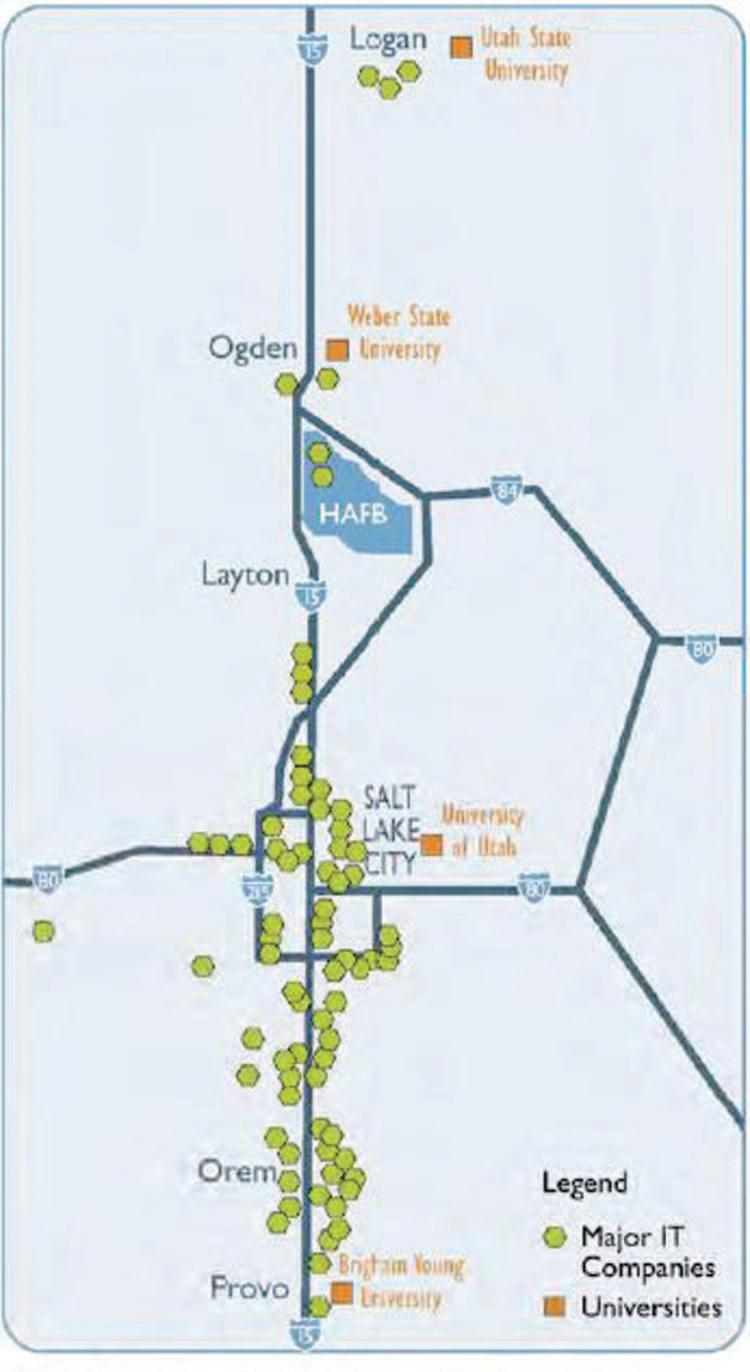
Utah’s Technology Corridor spans 70 miles and includes multiple technology innovators, Centers of Excellence, and key university partners, as well as a well-educated workforce to support technology development.
During the past year GOED was able to facilitate the creation of alliances between key businesses that helped make the Information Technology Cluster in Utah a more connected industry. Specifically, GOED was able to help the Mountain West Capital Network (mwcn.org), Utah’s largest business networking organization, which is devoted to entrepreneurial success. GOED also assisted the Women Tech Council with its first annual Women Tech Council awards (www.womentechcouncil.org), recognizing women who are leading in the technology industry in Utah. This relationship has proven beneficial for everyone involved.
GOED has been able to attend and sponsor many conferences, which have helped develop and build up our Cluster area, as well as bring added benefit to Utah businesses. In the Information Technology Cluster GOED was privileged to help sponsor the Utah Open Source Conference (www.utosc.com). This is an “up and coming” area of IT that includes companies developing for the Linux and Unix environments. This conference helps companies that rely on and develop open source software.
Life Sciences
The Life Sciences industry is very strong in Utah, employing in ex c ess of 27,000 people w ith salaries that average 147% of the State’s average. Across the nation, and globally, Utah is a recognized leader in medical devices and pharmaceuticals, and both sectors continue to grow. In GOED we continue to develop emerging sectors and engage in activities to grow the entire industry.
Utah and its Life Science companies had a strong presence at the 2008 Biotechnology Industry Organization (BIO) International Convention in San Diego. The BIO International Convention is the largest biotechnology event in the world with over 14,000 in attendance. The conference showcases companies and universities, as well as emerging technologies. There were more than 40 countries and over 40 states in the U.S. represented at the conference. The Utah Life Science industry was represented by the Economic Development Corporation of Utah, the
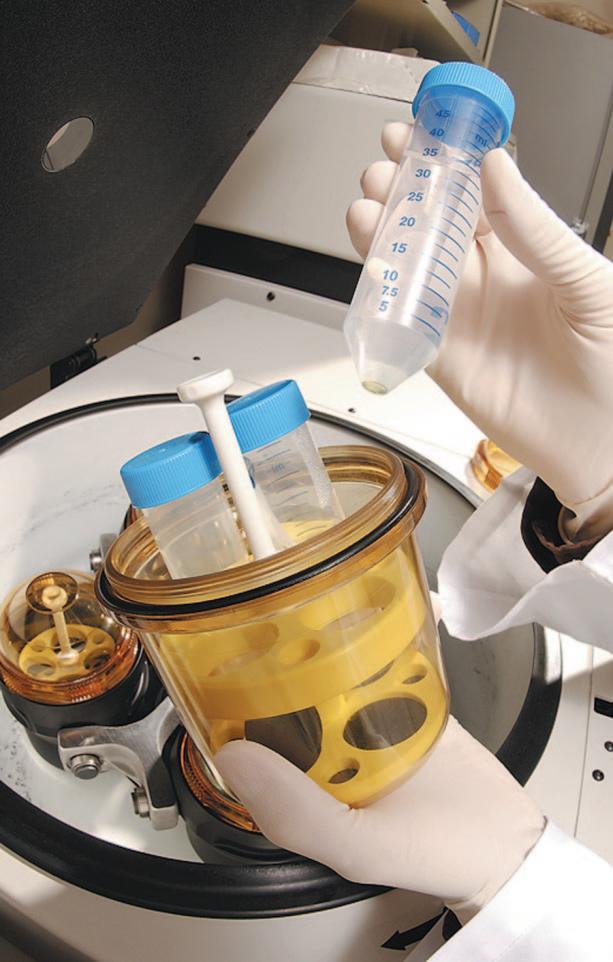
Governor’s Office of Economic Development • Annual Report 2008 7
TARGETED ECONOMIC CLUSTERS
GOED, 16 companies, six universities and/or colleges and university-related groups and one trade organization. Important outcomes for Utah’s presence at the BIO conference include potential partnerships with Canadian universities and companies, as well as attracting life science companies to expand to Utah.
A qualified and diverse workforce is necessary to help grow the Utah Life Science industry. Utah is leveraging the Wo rk force Innovation and Regional Economic Development (WIRED) $5 million grant awarded from the U.S. Department of Labor. The activities of this grant are focused on creating education programs that help provide a we ll-qualified workforce for the Life Science industry. This is in direct response to growing needs of this high tech industry that have indicated they will need 1,200 additional workers in the future. GOED has nine partners engaged on this grant, including Utah Valley University, Salt Lake Community College, Westminster College, various school districts, The Utah Science Center, Department of Workforce Services and Utah Science, Technology and Research (USTAR).

Utah is focused on creating education programs required for a well-qualified workforce.
Within the Life Science Cluster, the natural products/dietary supplement sector is very large, with several national leaders located in the State. GOED is helping to coordinate activities that will support this dynamic industry. Efforts this past year were focused on understanding the industry, working with trade associations and developing potential areas to assist this business sector.
Defense and Homeland Security
The Utah Defense and Homeland Security Cluster area continues to grow with estimated revenues of over $3.9 billion and nearly 31,000 employees in the industry state-wide. Hill Air Force Base (HAFB) recently picked up additional workload related to A-10 refurbishment and designation as a primary maintainer for the F-35 (Joint Strike Fighter) as it comes on-line to replace the F-16 fighter, which has been a primary source of employment at the HAFB for many years.
GOED, in partnership with the Office of the Governor, Hill Air Force Base, the Utah Defense Alliance, Utah Congressional delegation, State Legislature and many others, submitted a proposal to the U.S. Air Force, to have the service’s newest command, Cyber Command, stationed at HAFB. If selected, Cyber Command could bring 550 to 2,500 military and federal employees to the Base as well as hundreds, or even thousands of related civilian support contractor personnel. Utah and Hill Air Force Base have unique attributes and capabilities for Cyber Command to be very successful. The Air Force expects to make a stationing decision by September 2009.
Governor’s Office of Economic Development • Annual Report 2008 8
GOED is very involved with the Air Force, Utah Defense Alliance (UDA), Military Installation Development Authority (MIDA) and local officials in the development of Falcon Hill National Aerospace Research Park. Falcon Hill is among the most strategically located aerospace research parks in the country. Positioned along Interstate 15 at Hill Air Force Base, Falcon Hill will offer space both inside and outside the Air Force fence. This 550-acre private development, under an Air Force Enhanced Use Lease, will replace over a million square feet of antiquated Air Force buildings through in-kind payments, attract aerospace and aviation companies from across the country and has the potential to create thousands of new high-paying jobs in Utah.
TARGETED ECONOMIC CLUSTERS

In partnership with GOED, private companies, military installations and academic institutions, the Unmanned Vehicle industry continues to build within the State and gain recognition from across the country. In the fall of 2007, four Utah Teams along with 85 others from across the country, participated in the Defense Advanced Research Projects Agency’s (DARPA) Urban Challenge, requiring unmanned, autonomous ground vehicles to negotiate busy intersections and avoid obstacles. Three Utah Teams made it through preliminary competition and were invited to the final event, further strengthening Utah’s reputation in this emerging industry.
Several unmanned vehicle programs, primarily sponsored by the Department of Defense, have relocated to Utah to take advantage of the testing and training opportunities afforded by the U.S. Army’s Dugway Proving Ground and U.S. Air Force’s Utah Test and Training Range. These are unique areas which allow both ground and air unmanned vehicles to be tested and trained through a wide range of capabilities and several more companies and programs have expressed interest to move here. GOED has enhanced this effort by fostering the start of the Utah Chapter of the Association for Unmanned Vehicle Systems International (AUVSI) as well as annual sponsorship of the Utah Pavilion at the preeminent industry trade show hosted by AUVSI.
Av iation and Aerospace
The majority of the Utah Aerospace and Aviation industry is located in northern Utah, as it grew from activities originally generated by Hill Air Force Base. Today, the industry has expanded in breadth and depth and companies from across the country recognize the importance and attraction of being in Utah. One segment of this industry that has experienced tremendous growth, is the Advanced Composites industry.
The Advanced Composites industry started in Utah a number of years ago as Hercules, known today as ATK. Today the industry encompasses almost 10,000 employees representing over 123 companies, up from 70 just a few years ago, with such industry leaders as Hexcel, ATK, ITT Integrated Systems, formerly EDO Fiber
Governor’s Office of Economic Development • Annual Report 2008 9
Rendering of Falcon Hill National Aerospace Research Park at Hill Air Force Base.
TARGETED ECONOMIC CLUSTERS
Science, Rocky Mountain Composites, ACT, and many others, as well as the composite activities on-going at Hill Air Force Base and many of our universities. Utah companies are involved in composites that support aircraft, missiles, medical, industrial, energy and recreational applications. The Utah industry expects to grow by almost 2,500 employees within the next five years, and many are ahead of their projections.
GOED’s role in Advanced Composites has been to facilitate the discussion and lead the effort amongst industr y representatives, academic institutions and state and private organizations. This past year’s efforts included addressing workforce training, research and development and access to fiber resources for smaller companies. In partnership with Salt Lake Community College, Davis Applied Technology College (DATC) and Ogden-Weber Applied Technology College (OWATC), training needs were addressed across the industr y, and Salt Lake Community College recently opened its first composites training program, which will complement programs already established at DATC and OWATC. GOED, in partnership with EDCUtah, also sponsored a Utah Pavilion at the preeminent advanced composites trade show, the Society for the Advancement of Material and Process Engineering (SAMPE). Several companies that participated in the Show in 2007 or 2008 have already received additional workload and hired more employees due to direct contacts made there.

Governor’s Office of Economic Development • Annual Report 2008 10
A few of the various aircraft maintained by Hill Air Force Base.
TARGETED ECONOMIC CLUSTERS
Utah Code Ann. § 63-38f-1901. Military Installation Partnerships
In the 2005 General Session, the Utah State Legislature, recognized potential employment opportunities and the economic significance of federal military installations located within the state. Senate Bill 141, signed by Governor Jon Huntsman, March 17, 2005, appropriated $5,000,000 to the Governor’s Office of Economic Development to be dispersed for projects that would:
1. Enhance military value of Utah military installations
2. Preserve existing workload and employment
3. Create new employment opportunities for Utah citizens
To accomplish these goals, GOED partnered with the Utah Defense Alliance (UDA), that, in turn worked with Logistics Specialties, Inc., Hill Air Force Base and U.S. Army Dugway Proving Ground. UDA distributed $4,500,000 to Hill Air Force Base and $500,000 to Dugway Prov ing Ground for specific programs.
The results, on both installations, have been very successful, and will continue to be so for years to come. The $5,000,000 investment will ultimately result in the creation of 613 ongoing high-paying skilled and professional positions with an estimated annual payroll of $32,775,000 to $37,090,000. To date, in its third year, the program has generated over 250 full-time jobs, on-track with expectations.

Governor’s Office of Economic Development • Annual Report 2008 11
Aerial view of Hill Air Force Base.
BUSINESS AND TECHNOLOGY PARKS

The Business & Technology Parks program works with public and private partners to provide the physical locations where the state’s industry clusters can co-locate, collaborate and innovate.
A recent report by Battelle emphasizes the importance of research and innovation centers to economic development:
“Research parks are emerging as strong sources of entrepreneurship, talent, and economic competitiveness for regions, states, and nations. They have become a key element in the infrastructure supporting the growth of today’s knowledge economy. By providing a location in which researchers and companies operate in close proximity, research parks create an environment that fosters collaboration and innovation and promotes the development, transfer, and commercialization of technology.1”
There are other benefits, too. As we promote new business and technology centers for the state, we can help reduce the need for new infrastructure. Access to light rail and commuter rail, and a location that will not require major new roads are key factors as we work to cluster our employment into regional nodes that reduce commuting costs, travel times and pollution.
Currently, over 300,000 people nationwide work in 134 university research parks alone. If we add in those working in major tech commercialization parks drawing upon industry clusters and university research, the number climbs to well over one million.
For the future, nationwide, tech parks are transforming from stand-alone office parks to mixed-use centers that serve as a key tool of economic development, with a full range of office types – from incubators, to labs and light industrial, in addition to the typical Class A office space – in addition to housing and retail – that serve both research and a wide range of industry needs.
The state is ahead of this trend, and is working on several tech centers that will continue the tradition of the state’s first research park, the University of Utah’s Research Park, in serving as centers of innovation and excellence.
Falcon Hill National Aerospace Research Park
Last year, GOED partnered with the Air Force, Utah Defense Alliance (UDA), Military Installation Development Authority (MIDA), Hill Air Force Base and other interested parties in producing a major win for the State as the Falcon Hill National Aerospace Research Park project got off the ground.
Governor’s Office of Economic Development • Annual Report 2008 12
Rendering of Falcon Hill National Aerospace Research Park, Hill Air Force Base, Utah.
1 Characteristics and Trends in North American Research Parks: 21st Century Directions, Battelle Memorial Institute, 2007, pp vii.
BUSINESS AND TECHNOLOGY PARKS

In August 2007, in a nationwi de co mpetition, the Air Force selected Utah’s Woodbury Corporation as the lead developer for Falcon Hill, highlighting the expertise and project connectivity local deve lopers have. This has enhanced the overall benefit of the project to the State. Land for Falcon Hill will be let out in long-term ground leases to the master developer who will pay for the leases by constructing buildings for Hill Air Force Base as payment in-kind.
Falcon Hill is a unique project among Air Logistics Centers in the U.S. It is planned as a strategically located 550-acre tech center that will transform the west side of Hill Air Force Base into a world-class center for aerospace, advanced composites and defense. Falcon Hill is ideally suited to support the State’s Clusters Strategy – particularly because of its proximity to key companies in these key industry clusters.
Falcon Hill will have space available both inside and outside the HAFB security fence and will feature over 2 million square feet of commercial space – including office, hotel and retail – in its first phase alone. Two more phases will follow.
Falcon Hill, Phase One –
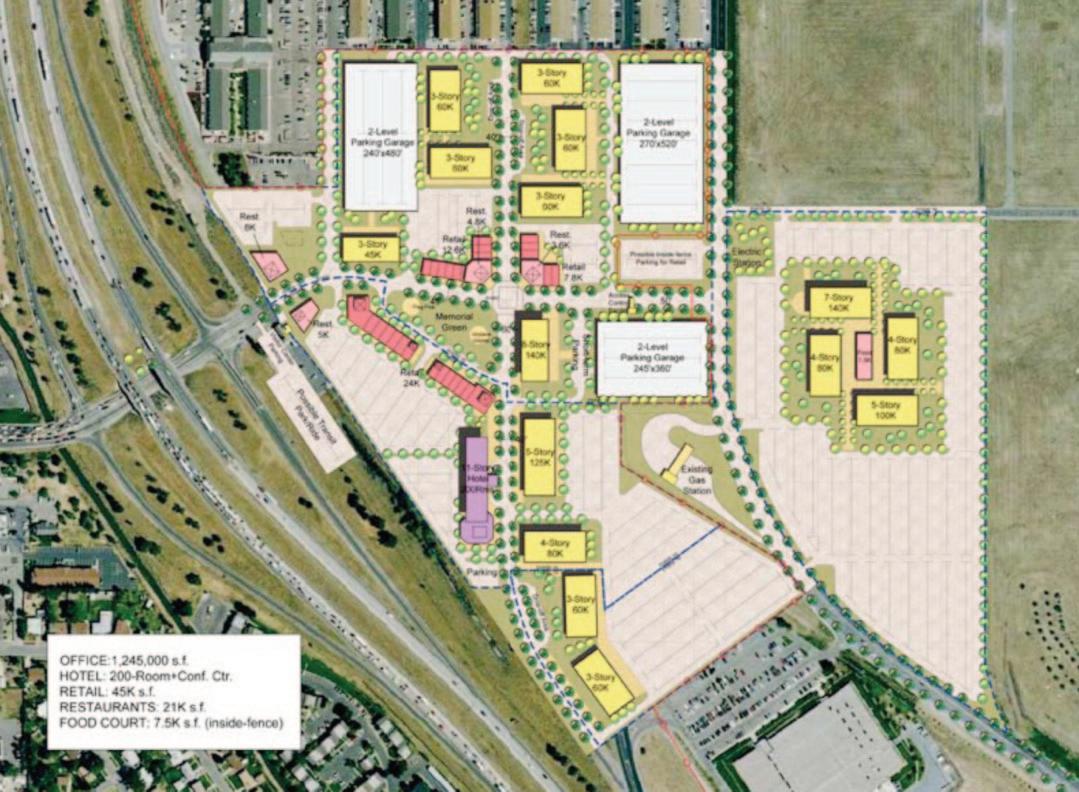
Office Square Footage
1,245,000 square feet
Typical Floor Plate
20,000 square feet
Retail
45,000 square feet
Restaurant
21,000 square feet
Fiber Optic Connectivity
Redundant Power
Governor’s Office of Economic Development • Annual Report 2008 13
West Gate, HAFB
Rendering of Falcon Hill National Aerospace Research Park looking to the east.
BUSINESS AND TECHNOLOGY PARKS
Other Sites Being Considered
Draper/Bluffdale Tech Center
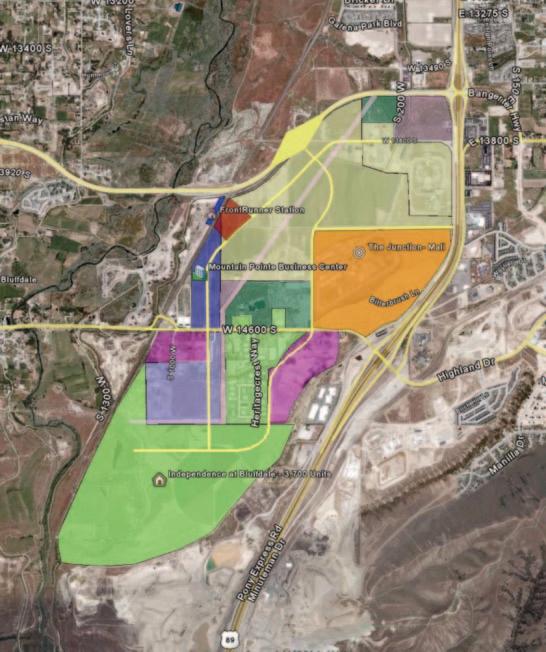
Industry-Generated Development Proposal
Iron County

GOED is working with the legislature and many stakeholders on conceptual planning for a major mixed-use tech, residential and commercial center at the south end of the Salt Lake Valley on state land adjacent to the Utah State Prison. This site has been described by real estate industry leaders as “ground zero” for the state’s future economy. The site has excellent access to both Salt Lake County’s and Utah County’s labor forces. Many tech companies indicate the site would be ideal for companies attempting to attract employees from as far north as Far mington and as far south as Payson. Also, with its location next to the intersection of two freeways and with commuter rail station planned for the area, the site has immense potential as a transportation hub and commercial and employment center.
The Business & Technology Parks Program is currently working with Cedar City and Southern Utah University on a proposal for a business and tech park that would serve both the University and local business community, and serve as a focal point for recruited businesses. Three sites are currently being considered.
Washington County
Washington County developers are considering master-planned developments in the county. They are working to determine the feasibility of a tech site on or adjacent to one of their current developments and how it would benefit the state’s economic development strategies and recruiting efforts.
Governor’s Office of Economic Development • Annual Report 2008 14
State Lands Being Considered for Draper/ Bluffdale Tech Site
CENTERS OF EXCELLENCE (COE)
“Our Job is Jobs”
The Centers of Excellence program plays a unique role in helping to grow sophisticated technology based companies in Utah, by filling funding gaps and encouraging entrepreneurs to partner with Utah colleges and universities, to effectively commercialize technology from these institutions.
The Stepping Stones to Job-Creating Companies
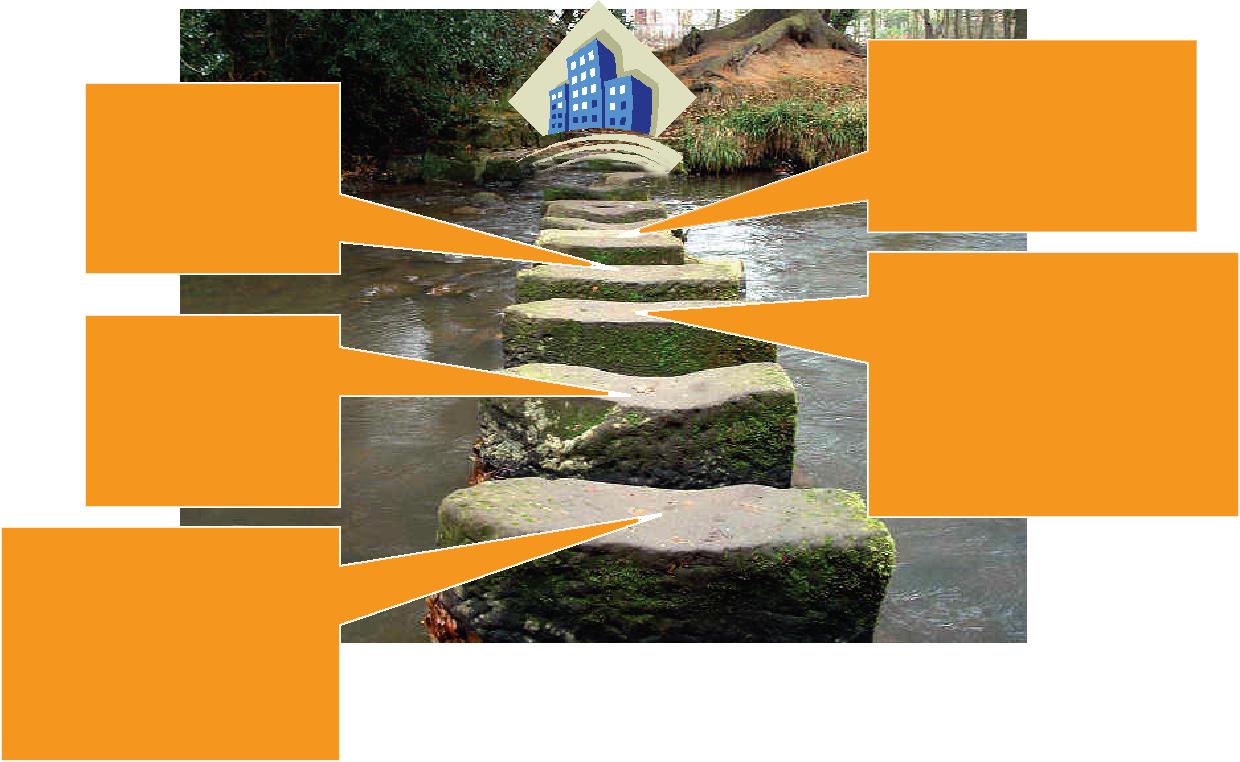
Licensee Grants Come to Fruition During FY2007-08
During the 2007 Legislative Session, the Legislature passed and the Governor signed into law changes to the COE statute that permitted ongoing support of grants to licensees of technologies developed at Utah’s colleges and universities. Due to these changes, during the FY2007-08 selection process, licensees of any former Center of Excellence were eligible to apply for a Licensee Grant.
For FY2007-08, the funded teams included 9 licensees, 3 of which had Companion Centers which were also recommended for funding. Another 8 stand-alone University Centers received funding, for a total of 11 University Centers, and a final 8 University Grantees received “Business Team” support, which is intended to develop a better understanding of the market before further grants are made. For FY2007-08 the Centers of Excellence program supported a total of 28 teams, and 25 different technologies, w ith 20 selected for significant development funding.
The purpose of the Centers of Excellence program is to accelerate the commercialization of promising technologies that have strategic value for Utah. The end goal of the COE program is to help drive economic development and job creation.
The excellent progress made by the licensees funded during FY2007-08 in creating jobs and expanding the success of their businesses and strengthening Utah’s economy led to significant changes to the program for FY2008-09. The program has been refocused to help provide funding to the licensee, the company that is licensing a university-developed technology.
The intent of this grant funding is to help accelerate the process of taking these leading edge technologies to market. Companies of any size are eligible to apply, including startups as well as existing companies that are planning to create a new product or product line from the licensed technology. The goal of these funds is to help defray the risk in taking these innovative new technologies to market in order to encourage more such licensing and the accompanying job creation that comes from exciting new market opportunities.
Governor’s Office of Economic Development • Annual Report 2008 15
Angel Capital Centers of Excellence Licensee Grants University Research and Technology (Federal, Corporate, USTAR)
1 2 4 5 3
Venture Capital (including Fund of Funds) Friends & Family Funding
CENTERS OF EXCELLENCE (COE)
FY2008-09 Selection Process Completed in Calendar Q2 2008
For the FY2008-09 selection process, there were two categories of eligible applicants. First were 5 University Centers which had received their first year of funding in FY2007-08 and who were eligible for a second year of funding as a University Center. The second group was any company, an existing firm or a startup, which was newly licensing a university developed technology.
For the FY2008-09 Solicitation, 3 of the 5 eligible University Centers and 36 licensees submitted proposals for a total of 39 proposals received, of which 21 licensees were selected for funding and 1 University Center was recommended for a second year of funding, bringing the total to 22 proposals recommended for a COE grant this year.
For the FY2008-09 funding recommendation, the Centers of Excellence program continued to refine the selection process. The linchpin of the Centers of Excellence program is the COE Advisory Council, anchored by members of the GOED Board and by the State Advisory Council on Science and Technology (SAC).
The COE Advisory Council is a group of seasoned technology industry executives, CEOs and CTOs, VPs and Senior Directors, who are interested in helping Utah and the Centers of Excellence program succeed. This year there were 28 volunteer reviewers on the Advisory Council, 5 of them new to the program for FY200809. For the FY2008-09 selection year, the COE Advisory Council conducted 39 reviews of 3 University Center proposals and 36 licensee grant proposals. The funding requests this year were in excess of $4.5 million, significantly exceeding the current COE budget of $2.75 million.
VisualShare – Salt Lake City
VisualShare is a pioneering life sciences software-as-a-service healthcare technology company. VisualShare provides technology that permits remotely located medical professionals to share images as well as notes and information about those images, providing access to high quality medical care and specialists for patients everywhere. This is the first solution available in the marketplace that provides real-time image collaboration across clinical locations.
VisualShare, established in 2005, is a spin-out of the Center of Excellence for Electronic Medical Education (CEME) at the University of Utah and is also a licensee grant recipient. The Company develops image-based decision support solutions for telehealth and diagnostic imaging as part of an exclusive license to all intellectual property developed in CEME.

As a licensee grant recipient, a major goal of the Company was to use the COE funds to create two new sales and marketing positions that focused on creating brand awareness, develop a marketing plan and expand the existing customer/sales pipeline. “I am grateful for the COE program because it has allowed VisualShare to hire the necessary expertise in sales and marketing that, in turn, has led to an increase in sales revenue more than five times from the previous year,” says Patricia Goede, President and Co-founder.
Governor’s Office of Economic Development • Annual Report 2008 16
CENTERS OF EXCELLENCE (COE)
In addition to funding new positions and thereby creating jobs for Utah, the relationship with COE provided access to business expertise that allowed the Company to gain feedback on “go to market” strategies, develop a business pitch and prepare for fundraising. Associates of the COE program carefully reviewed and critically evaluated the business model and facilitated introductions to the business community that led to introductions to the larger investment community. “The COE program contributes tremendous value in helping develop a network of opportunities for companies and the Utah business community,” states Goede. “The human resources at COE take a hands on approach and are very supportive of each Center.”
Larada Sciences, Inc. – Salt Lake City Larada Sciences, Inc., formed in 2006, delivers medical products and services based on breakthrough technology, for the safe and effective non-chemical treatment of head lice. Pediculosis (head lice) is a multibillion dollar problem that afflicts about 25% of children by the time they’re teenagers and the problem is grow ing rapidly because head lice are evolving resistance to many of the currently used lice pesticides. Larada’s first product, the “LouseBusterT”, is a medical device that uses a high volume of warm air to kill head lice and their eggs, in a way that is completely chemical-free, safe, effective, inexpensive, and requires only one treatment lasting about 30 minutes.
Larada Sciences is a spin-out company of the University of Utah Center for Alternate Strategies for Parasite Removal. The LouseBuster technology was the driving innovation behind the Center. This device (the “LouseBuster™”), kills lice and their eggs with a large volume of warm air, precisely temperature-controlled, that is delivered to the patient through a special applicator that exposes lice and eggs clinging at the base of hair shafts to the air. Preliminary trials have demonstrated the device is safe and very effective, killing virtually all eggs and a majority of hatched lice, leading to cure rates of virtually 100% from a single 30 minute procedure. Patents are pending and licensed, and full clinical trials are currently underway that will lead to FDA clearance and CE marking. The company will soon be ready to complete the final product design and certification testing, then scale-up for manufacturing and market entry.
COE funding has helped Larada achieve significant milestones including:
•Developing critical proof-of-concept and working prototypes
•Attracting matching funds for research and development
•Attracting research and distribution partners
•Expanding intellectual property rights
•Securing a major round of private investment capital
“We consider our relationship with the COE and the State of Utah more than a small affiliation. The plain truth is that Larada Sciences would have never gotten off the ground or grown, or been able to grow as fast as we have without the financial support of the COE.” – Randall
Block, President & COO
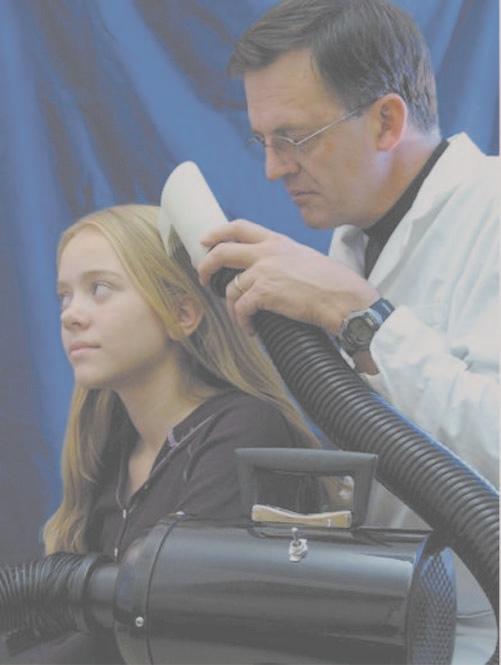
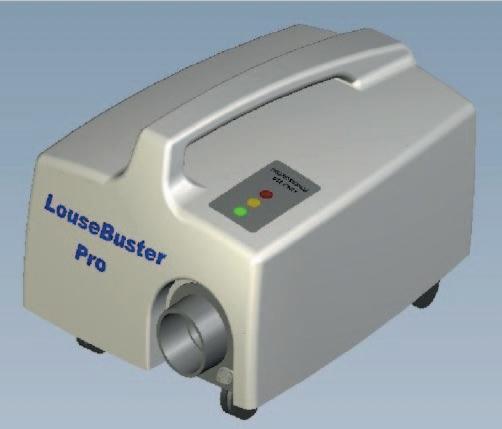
Governor’s Office of Economic Development • Annual Report 2008 17
CORPORATE RECRUITMENT AND INCENTIVES
Overview
The Corporate Recruitment and Incentives program helps GOED fulfill its mission by recruiting companies to Utah that add strategic value to Utah’s economy. In addition, GOED incents existing Utah companies for business expansion and retention. These companies create new, highpaying jobs that help diversify the state economy, increase the tax base, attract and retain top-level management, and encourage graduates of in-state universities to remain in Utah and improve the standard of living of its citizens.

To recruit new companies to the state and assist the expansion of existing companies, GOED offers incentives in the form of post performance refundable tax credits and grants. The incentive amount and duration is based on statutory guidelines and evaluation criteria including: the number and salary of jobs created, amount of new state revenue, long term capital investment, competition with other locations, and whether the company is within a targeted industry. Targeted industries are outlined in detail in the “Targeted Economic Clusters” section of this report.

A unique feature of Utah’s corporate recruitment and expansion incentives is that funds are awarded on a post performance basis so that companies must meet specific milestones, including generating new state tax revenue, before incentives are disbursed. This feature eliminates risk and assures a positive return on investment to the State and citizens of Utah.
GOED contracts with the Economic Development Corporation of Utah (EDCUtah) to help identify and recruit companies to the State. In addition to proactive and strategic recruitment services, EDCU also assists companies through the relocation process, including site selection, interaction with local government entities and data gathering. EDCU does not represent the state with regard to incentive commitments as this is a governmental function handled exclusively by GOED. GOED works in close partnership with EDCU to make a company’s relocation to Utah as smooth as possible.
During the recent 2008 General Session, the Utah State Legislature passed SB185, which modified the Economic Development Tax Increment Financing (EDTIF) incentive from a tax rebate to a refundable tax credit. The Legislature also passed HB20 which changed the definition of high paying jobs from median wage to average wage.
Governor’s Office of Economic Development • Annual Report 2008 18
Governor Huntsman reviews plans for the new Procter & Gamble facility in Box Elder County.
P&G ground breaking ceremony, May 2008.
CORPORATE RECRUITMENT AND INCENTIVES
Incentive Programs:
• Economic Development Zone Tax Increment Financing (EDTIF)
A post-performance refundable tax credit for up to 30% of new state revenues (includes state corporate, sales and withholding taxes) over the life of the project (typically 5 – 10 years).
• Industrial Assistance Fund (IAF)
A post-performance grant for the creation of high-paying jobs in the state.
• Economic Opportunities (EO)
State-funded monetary assistance to projects furthering state economic interests. Twenty-percent of the IAF is designated for this purpose.
• Rural Fast Track (RFT)
Small companies in rural Utah (counties with a population less than 30,000 and average household income less than $60,000) may be eligible for incentives for creating high paying jobs. Twentypercent of the IAF is designated for this purpose.
• Rural Broadband Service Fund
A restricted account to be used for grants to providers for deploying broadband service in rural Utah.
• Motion Picture Incentive Fund (MPIF)
The Motion Picture Incentive Fund attracts film production with a post-performance rebate plan of 15% of total dollars spent in the state.
Special Incentives:
• Custom Fit Training (administered through local communities)
Custom Fit training money is used to help companies train employees and is administered generally through state colleges and state applied technology centers.
• Enterprise Zones (incentive paid by local communities)
Under the program, certain types of businesses locating to, or expanding in a designated zone may claim tax credits provided in the law.
• Private Activity Bond (administered by the Department of Community and Culture)
The Private Activity Bond is Utah’s tax-exempt bonding authority creating a lower cost, long-term source of capital under the Federal Tax Act of 1986.
• Recycling Zones (incentive paid by local communities)
In 1996, the Utah Legislature created the Utah Recycling Market Development Zone Program which focuses on recycling as an economic development tool.
•
Governor’s Office of Economic Development
Annual Report 2008 19
CORPORATE RECRUITMENT AND INCENTIVES
Number of Jobs Incented

New State Revenue (Over Ten Years)
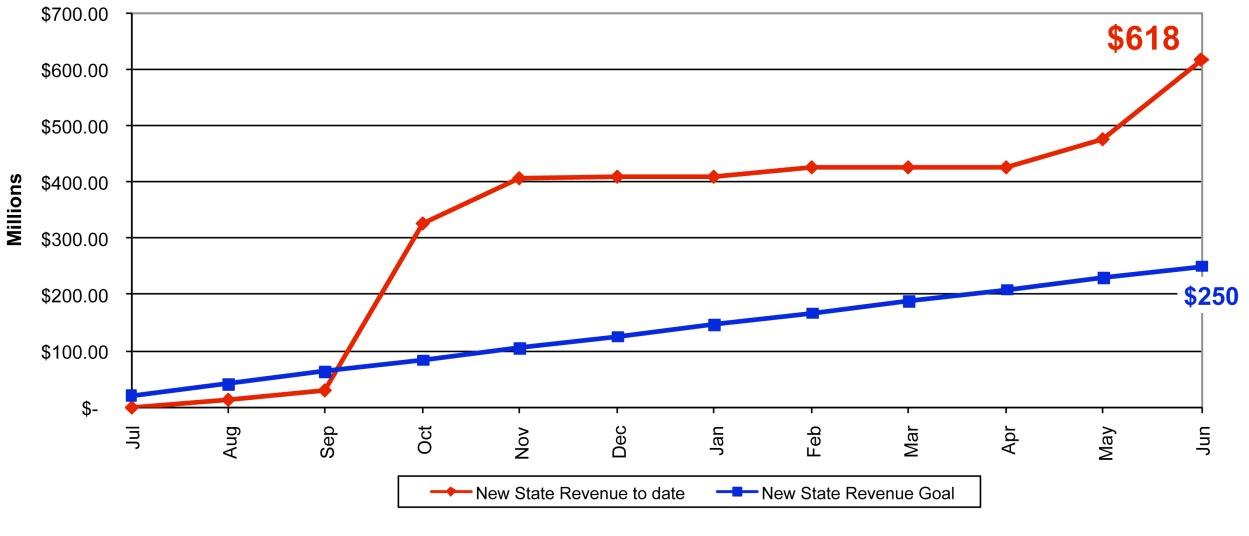
Capital Investment

New State Wages (Over Ten Years)
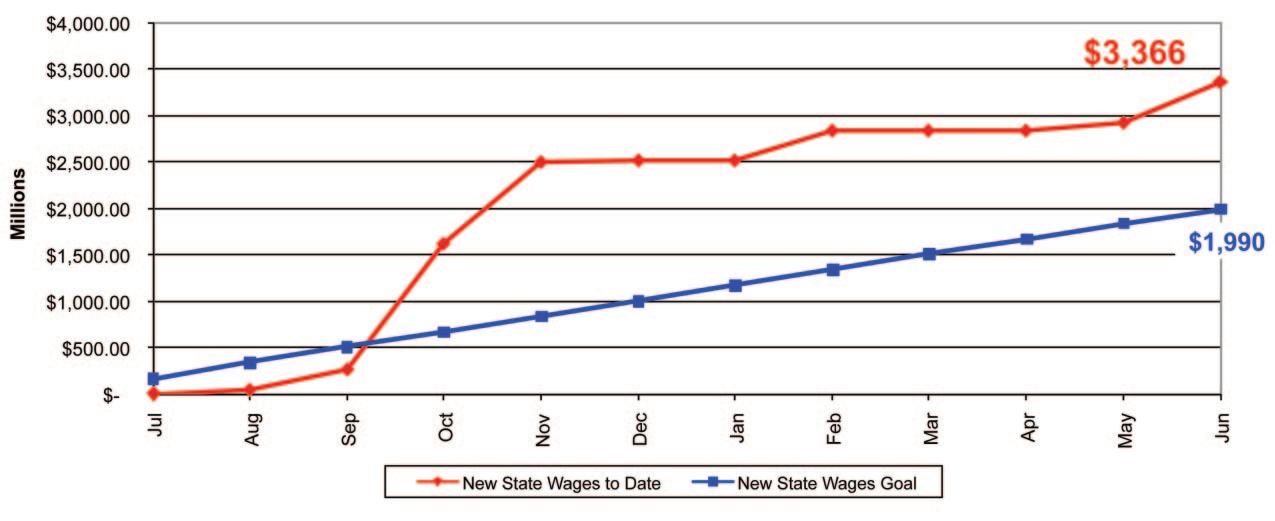
Governor’s Office of Economic Development • Annual Report 2008 20
CORPORATE RECRUITMENT AND INCENTIVES
Utah Code Ann. § 63M-1-901. IAF and Economic Opportunity Projects Awarded in Fiscal Year 2008
Four IAF projects totaling $2,000,000 awarded during FY 2008
Delta Air Lines: Startup of direct flights from Salt Lake City to Paris, France.
• $250,000 incentive over 16 months
• First direct trans-Atlantic flights from Salt Lake City to Europe
• Estimated economic impact greater than $90,000,000
• Estimated local job creation of at least 1,100 jobs
•Increased tourism and travel options for Utahns
FiberTek: New manufacturing facility in Nephi, Juab County.
• $1,250,000 incentive over 10 years
• 99 new jobs
• $13,612,000 New State Revenue ($1,043,000 Withholding, $6,820,000 Corporate, $5,750,000 Sales)
• $32,500,000 Capital Investment
• $36,589,000 New State Wages
Southern Classic Foods: New manufacturing facility in Ogden, Weber County.
• $300,000 incentive over 10 years
• 94 new jobs
• $1,262,000 New State Revenue ($837,000 Withholding, $393,000 Corporate, $32,000 Sales)
• $10,260,000 Capital Investment
• $22,332,000 New State Wages
Bar nes Bullets: Relocate and expand existing facility to Mona, Juab County.
• $200,000 incentive over 10 years
• 42 new jobs and 53 retained jobs
• $446,000 New State Revenue ($321,000 Withholding, $125,000 Sales)
• $5,000,000 Capital Investment
• $13,370,000 New State Wages
IAF commitments
• Standard IAF committed $13,820,635 representing 32 companies
•Economic Opportunities committed $900,000 representing 3 projects
•Rural Fast Track Program committed $530,000 representing 10 companies
Governor’s Office of Economic Development • Annual Report 2008 21
CORPORATE RECRUITMENT AND INCENTIVES
Utah Code Ann. § 63M-1-2406 & 2407. EDTIF Projects Awarded in Fiscal Year 2008
Eleven EDTIF projects totaling $170,210,611 awarded during FY 2008 $615,903,302 in New State Revenue
• $150,791,245 Withholding
• $365,207,477 Corporate
• $99,904,580 Sales
Estimated Partial Rebates for Fiscal Year 2009 24 projects with projected payouts totaling $10,414,922
• $4,001,664 Withholding
• $4,402,395 Corporate
• $2,010,863 Sales
Estimated Tax Credits for Fiscal Year 2009 Tax credit certificates will be issued for use beginning fiscal year 2010.
FiberTek: New manufacturing facility in Nephi, Juab County.
• $2,750,000 incentive over 10 years
• 99 new jobs
• $13,612,000 New State Revenue ($1,043,000 Withholding, $6,820,000 Corporate, $5,750,000 Sales)
• $32,500,000 Capital Investment
• $36,589,000 New State Wages
Bar nes Aerospace: Relocate and expand current Ogden, Weber County, operations.
• $2,000,000 incentive over 15 years
• 474 new jobs and 145 retained jobs
• $7,927,000 New State Revenue ($5,595,000 Withholding, $28,000 Corporate, $2,305,000 Sales)
• $11,800,000 Capital Investment
• $150,221,000 New State Wages
Thermo Fisher Scientific: Manufacturing facility and research laboratory in Logan, Cache County.
• $2,735,000 incentive over 10 years
• 196 new jobs
•$ 9,118,000 New State Revenue ($2,501,000 Withholding, $6,471,000 Corporate, $146,000 Sales)
• $21,100,000 Capital Investment
• $68,054,000 New State Wages
The Procter and Gamble Company: New manufacturing facility in Box Elder County.
• $85,000,000 incentive over 20 years
• 1185 new jobs
• $280,739,000 New State Revenue ($66,000,000 Withholding, $185,000,000 Corporate, $29,739,000 Sales)
• $540,000,000 Capital Investment
• $1,278,000,000 New State Wages
Governor’s Office of Economic Development • Annual Report 2008 22
CORPORATE RECRUITMENT AND INCENTIVES
Hershey: New western distribution center in Ogden, Weber County.
• $2,600,000 incentive over 10 years
• 123 new jobs
• $13,009,000 New State Revenue ($2,199,000 Withholding, $10,505,000 Corporate, $306,000 Sales)
• $38,000,000 Capital Investment
• $48,860,000 New State Wages
Goldman Sachs: Expand current Salt Lake City facility.
• $20,000,000 incentive over 20 years
• 375 new jobs
• $81,763,000 New State Revenue ($39,903,000 Withholding, $38,564,000 Corporate, $3,297,000 Sales)
• $20,200,000 Capital Investment
• $886,727,000 New State Wages
Disney Interactive: Expand existing Salt Lake City operations.
• $5,250,000 incentive over 10 years
• 565 new jobs
• $16,989,000 New State Revenue ($13,640,000 Withholding, $1,648,000 Corporate, 1,701,000 Sales)
• $15,100,000 Capital Investment
• $330,678,000 New State Wages
Oracle: New data storage center in West Jordan, Salt Lake County.
• $15,124,000 incentive over 12 years
• 100 new jobs
• $50,415,374 New State Revenue ($2,759,034 Withholding, $44,327,059 Corporate, $3,329,281 Sales)
• $260,000,000 Capital Investment
• $73,574,249 New State Wages
eBay: New data storage center, Salt Lake County.
• $27,277,000 incentive over 10 years
• 50 new jobs
• $109,110,945 New State Revenue ($892,499 Withholding, $70,888,918 Corporate, $37,329,528 Sales)
• $436,000,000 Capital Investment
• $23,799,980 New State Wages
Cementation: New USA corporate headquarters operation, Sandy, Salt Lake County.
• $3,317,000 incentive over 10 years
• 422 new jobs
• $16,585,538 New State Revenue (4,883,486 Withholding, $955,500 Corporate, $10,746,552 Sales)
• $5,500,000 Capital Investment
• $130,226,301 New State Wages
Fresenius: Expand current Ogden facility.
• $4,157,611 incentive over 10 years
• 1,111 new jobs
• $16,630,445 New State Revenue ($11,375,226 Withholding, $5,255,219 Sales)
• $340,000,000 Capital Investment
• $303,339,000 New State Wages
•
Governor’s Office of Economic Development
Annual Report 2008 23
CORPORATE RECRUITMENT AND INCENTIVES
Utah Code Ann. § 63M-1-904. Rural Fast Track Program
Approved Rural Fast Track Projects
• 10 projects approved totaling $530,000
• $1,989,750 remaining balance
• 67 projected jobs created with salaries at least 110% of the county average
Applied Composite Technologies: Prosthetic foot manufacturer awarded $50,000 post-performance grant to create new foot and knee lines.
•Sanpete County, 12 jobs
B.W. Bowmar Company: Machine shop manufacturer awarded $50,000 post-performance grant to convert electricity for larger machines.
• Garfield County, 2 jobs
Bruno Engineering P.C.: Electrical engineering and design company awarded $50,000 post-performance grant to create office space and other infrastructure.
•Carbon County, 10 jobs
E.A.O Services: Machining and manufacturing shop awarded $50,000 post-performance grant for a new CNC machine, power upgrades and freight pad.
• Emery County, 1 job
Intermountain Electronics: Engineering and design of electrical controls awarded $50,000 postperformance grant to expand shop facilities, classroom and office space.
•Carbon County, 20 jobs
Mine Systems Company: Electrical and environmental sales and service company awarded $50,000 post-performance grant to expand business to include battery repair.
•Carbon County, 2 jobs
Pacific Central Steel Fabrication: Industrial steel fabrication shop awarded $50,000 post-performance grant to construct paint building.
•Carbon County, 3 jobs
Talon Resources: Engineering, consulting and surveying firm awarded $50,000 post-performance grant for new facility for mine safety equipment, vacuum trucks and repair/maintenance.
• Emery County, 11 jobs
TC Engineering P.C.: Engineering, design and surveying firm awarded $50,000 post-performance grant to purchase technology infrastructure and equipment for expanded facility.
•Kane County
Johnson’s Diesel Service: Auto and diesel truck repair shop awarded $50,000 post-performance grant to develop new shop facility.
• Emery County, 6 jobs
Governor’s Office of Economic Development • Annual Report 2008 24
CORPORATE RECRUITMENT AND INCENTIVES
Utah Code Ann. § 63M-1-2305. Rural Broadband Service Fund
1.44 projects approved totaling $846,850 (50% of the total projected cost of $1,693,700).
2. $153,150 balance remaining in the fund.
3. 3 pending applications that, if approved, would count towards fiscal year 2009.
4.Suggested appropriations
•An additional 12 applications were received but not approved because of the lack of funding. The total amount for these applications was approximately $301,640 (50% of the total projected cost of $603,281).
Approved Rural Broadband Projects:
Corporate Recruitment & Incentives
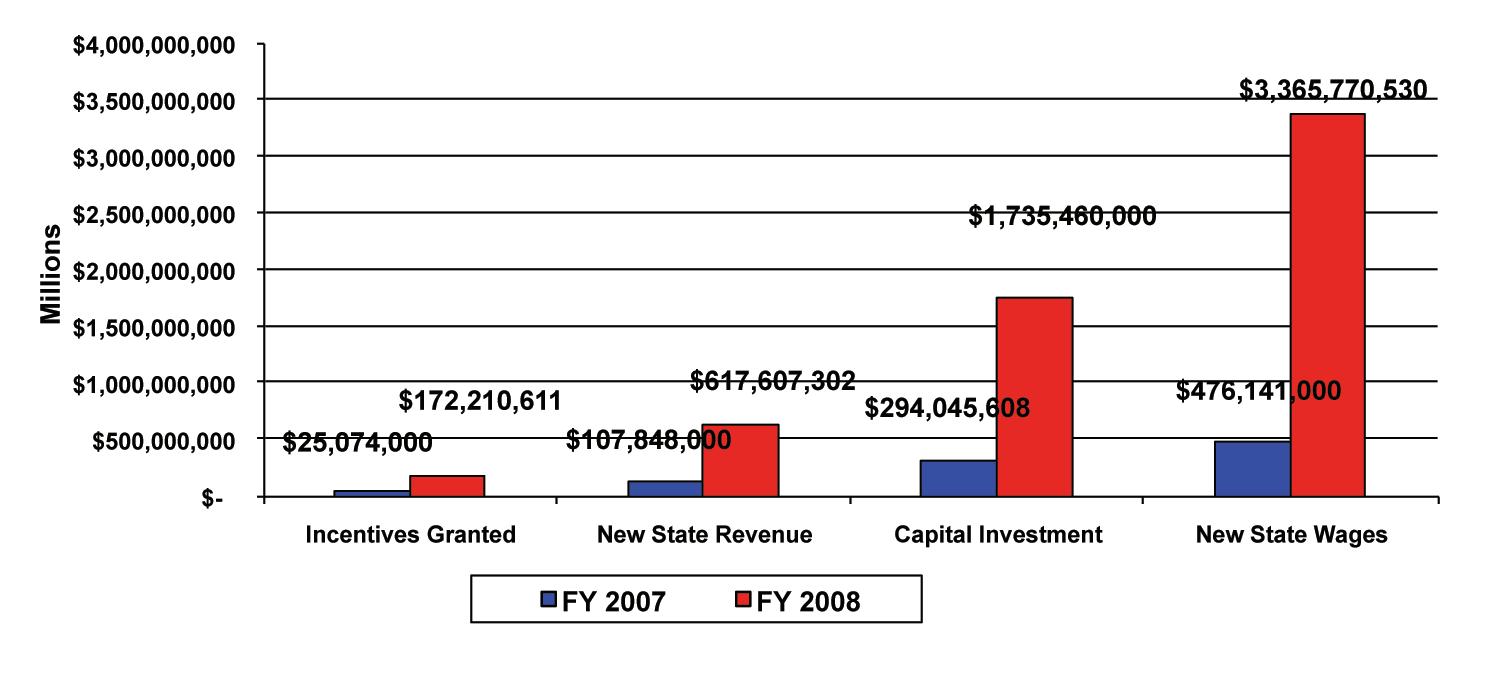
Governor’s Office of Economic Development • Annual Report 2008 25
Beaver1 Cache1 Carbon2 Iron2 Morgan1 Sevier1 Summit3 Tooele2
Wasatch8
Weber9
CountyNumber of Projects
Utah13
Washington1
BUSINESS RESOURCE CENTERS: ENTREPRENEURIAL DEVELOPMENT
Governor’s Office of Economic Development Business Resource Centers (BRC) will increase the success rate of Utah businesses, providing services that will ultimately allow new and existing businesses to grow and flourish. BRCs are entities established by GOED at Utah public institutions of higher-education or other appropriate community locations. They are certified one-stop resource centers providing coordination of business support, education, tracking of clients, access to sources of funding, training, technical expertise, talent, and networking for new and existing businesses. BRCs will partner with various business service providers located in their local service area and assist in the coordination of their activities, identify gaps in provided services, develop initiatives and provide opportunities. Business service provider partners will include federal, state, county, city, academic, private and any other business service providers that desire to participate with the BRC.

Business Resource Centers are required to secure matching funds for this effort. Matching funds may be in the form of cash or in-kind (facilities, services, personnel, etc.,), or as approved by GOED.
GOED will provide administrative oversight for the BRCs, maintain decision authority and act as fiscal agent. A Business Resource Centers Advisory Board, formed by GOED, will provide operational oversight of, and coordination with, the Business Resource Centers.
Report related to Utah Business Resource Centers Act, House Bill 37S01 signed into law on March 14, 2008.
GOED generated a Request For Proposal (RFP) in May 2008 and nine submissions were received from institutions across the State desiring to participate in the BRC Program.
Funds appropriated under this Act will not be used for new construction.
Governor’s Office of Economic Development • Annual Report 2008 26
The Utah Film Commission markets the entire State as a location for film and commercial production and promotes the use of Utah support services and professionals. The Film Commission is a client driven program, which services international, out-of-state production companies, in-state production companies and Utah support services and crew.
MPIF:
The Motion Picture Incentive Fund is a 15% post performance cash rebate on Utah expenditures for approved productions, with a cap of $500,000 per project and a minimum spend of $1 million in the State of Utah. The Leg islature increased the fiscal appropriation from $4 million in FY 08 to $5.5 million in FY 09. $2.5 million are on-going funds with $3 million being a one time allocation.
“High School Musical 3: Senior Year”
The Disney Feature Film “High School Musical 3: Senior Year,” began shooting on May 3, 2008. The film was shot pr imarily in Salt Lake City, with a 45 day production schedule. The film will premiere in theaters worldwide October 24, 2008.
At a special press conference for HSM 3, Emmy Award w inning director, Kenny Ortega said, “Who would have thought we could produce something for so little that would reach so many? ...I will always be thankful to Disney for allowing me to make the film with Don Schain and all of you in Utah. In my opinion (Utah is) one of the most creatively thriving communities in the country.”
In August 2007 “High School Musical 2” premiered and became the most watched cable movie of all time with a viewership of 17 million. The soundtracks of the first and second “High School Musical’s” were the number one selling CDs
FILM COMMISSION
Film Festival Economic Impact:
Sundance: $63,000,000
Motion Picture Production
Features Films/Independent Features/Cable Features
Total: 29
Jobs created: 1700
Production Days: 603
Economic Impact: $54,000,000
Other Production
Commercials/ Industrials/Documentaries/ Shorts & Stills
Total: 73
Jobs Created: 1,825
Production Days: 143
Economic Impact: $1,800,768
Grand Totals
Projects: 102
Jobs Created: 3,525
Production Days: 746

Governor’s Office of Economic Development • Annual Report 2008 27
Ashley Tisdale, Zac Efron, Vanessa Anne Hudgens, Governor Jon Huntsman, Kenny Ortega, Monique Coleman, and Corbin Bleu.
FILM COMMISSION
of 2006 and 2007 respectively, w ith over 18 millions copies sold.
The Utah Film Commission recently completed a new version of the “Filmed in Utah” brochure which shows the locations of famous films that have been shot in the state. Also, “Utah Hues,” a photo-book that was published by the Utah Film Commission showcasing locations across the state, was awarded a Gold Medal from the Utah Advertising Federation Awards in March of 2008.

Jared Hess directing the feature film
FILMS SHOT IN UTAH FISCAL YEAR 2008
Darkroom – Murray, Utah
Animals – Salt Lake City, Utah
White on Rice – Salt Lake City, Utah
Minutemen – Murray, Utah
Dragon Hunter – Utah
Adventures of Food Boy - Utah
The Singles Second Ward - Utah
Red Canyon – Cainville, Utah
The Yankles – Utah
CTU Provo – Utah
Monster in the Attic – Kanab, Utah
Two Young Men – Utah
Emma Smith: My Story - Provo, Utah
Friends for Life – Utah
Dadnapped – Magna, Utah
Lock and Roll Forever – Salt Lake City, Utah
The Jerk Theory – Salt Lake City, Utah
Cusp - Utah
American Mall – Provo, Utah
Hatching Pete – Midvale, Utah
Gentlemen Broncos – Summit County
Blank Slate – Salt Lake City, Utah
Star Trek (Second Unit) – Green River, Utah
High School Musical 3 - Salt Lake City, Utah
The Assignment – Sanpete County
High School Musical: Get in the Picture – Murray, Utah
Samantha Darko – Delle, Utah
Tree of Life – Utah
Governor’s Office of Economic Development • Annual Report 2008 28
“Gentleman Broncos.”
Exports Driving Utah Growth
Utah’s export growth is among the strongest in the nation. Since 2004, Utah’s GDP has grown over 18%.1 Much of this growth is fueled by the enormous increase in Utah’s exports. In 2004 Utah companies exported about $4.7 billion in merchandise. 2007 saw an incredible increase in trade with over $7.8 billion in exports. January 2008 was the largest export month in Utah’s history, accounting for $1.02 billion to countries throughout the world.2
Focus Countries
2007 At a Glance
Overall Merchandise
Export Growth (’04-’07): 65.6%
Utah GDP Growth (’04-’07): 18.8%
Focus Country Growth (’04-’07):
• China 214%
• India 1,765%
• Canada 9%
• Mexico 83%
Jobs Created (’04-’07): 20,621
Trade Delegation Visits: 36
Diplomatic Visits: 45
Companies Assisted: 317
Educational Seminars: 33
Trade Missions: 4
• China, Japan, Korea (Nov ’07)
• Mexico (Jun ’07)
• India (Oct ’07)
• Europe (Jun ’08)
In 2005 Governor Jon Huntsman designated four countries for trade missions. They are China, India, Mexico and Canada. These countries represent some of the state’s strongest trade partners, as well as some of the fastest expanding markets in the world. China and India are among the fastest growing economies and provide excellent opportunities for Utah companies to grow. Canada and Mexico have proven track records of success for Utah businesses. By focusing on these key regions, ITDO was able to assist Utah industries achieve tremendous export growth. Electronics exports accounted for 45% of the growth to China, while precious metals were responsible for nearly all growth to India.3
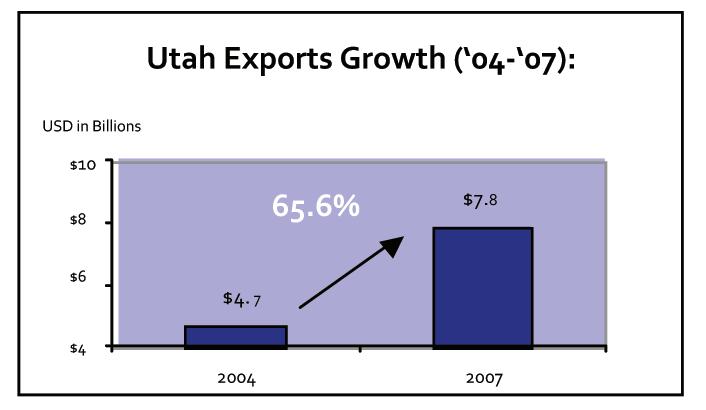

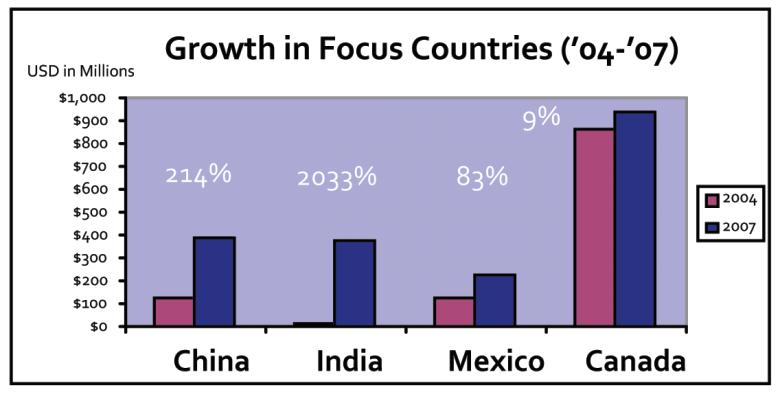
Utah Job Creation
Since 2005 exports have helped fuel Utah’s job creation, especially for small and medium-sized businesses. A total of 2,236 companies exported goods from Utah locations in 2006. Of those 1,906 (85 percent) were small and medium-sized enterprises (SMEs), with fewer than 500 employees. Export-supported jobs linked to manufacturing account for an estimated 4.1 percent of Utah’s total private-sector employment. Over one-seventh (14.8 percent) of all manufacturing workers in Utah depend on exports for their jobs.4 The Utah International Trade Office estimates that one job is created for every incremental $150,000 exported. As export figures grow, companies continue to expand and increase staff in order to manageably sustain development.
Incremental Jobs Created (’04-’07): 20,621
Governor’s Office of Economic Development • Annual Report 2008 29
TRADE AND DIPLOMACY 1U.S. Census Bureau 2 WISERTrade Database 3 WISERTrade Database 4U.S. Department of Commerce, International Trade Administration
INTERNATIONAL
INTERNATIONAL TRADE AND DIPLOMACY
Company Feedback
India Trade Mission
“Participating in the trade mission was a wonderful opportunity to define strategic alliances with Indian institutions of higher educat ion as well as partnerships with entrepreneurs and small business owners. Without the coordinated effort of the ITDO at GOED, Salt Lake Community College would have missed identifying opportunities with groups such as WIT or would have had to expend addit ional institutional resources to identify a successful partnership.”
—Karen Gunn, Dean, School of Pr ofessional and Economic Development, Salt Lake Community College
Korea Trade Mission
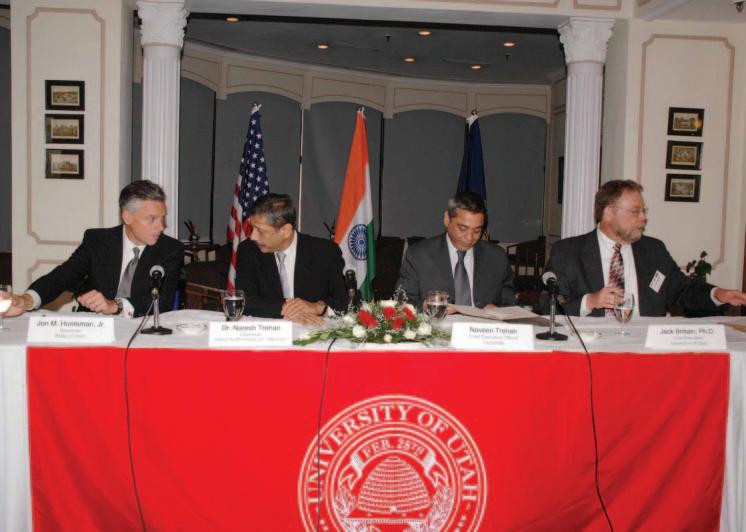
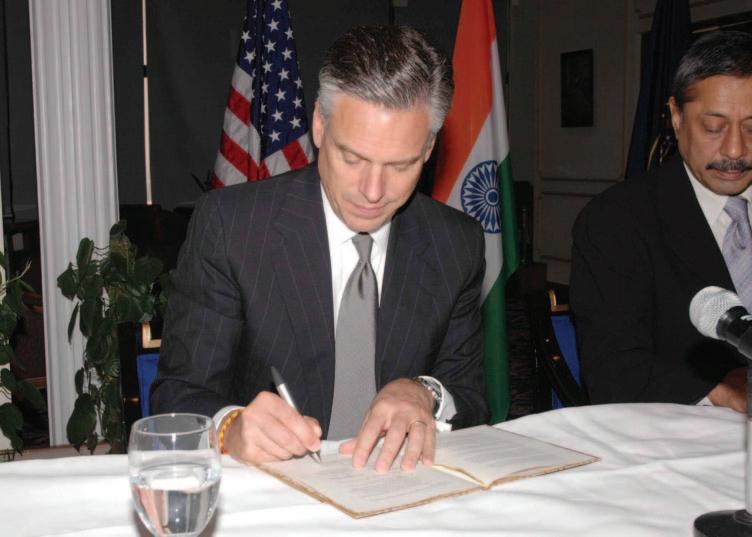

“All the meetings and networking activities were relevant and critical to our evaluation of the market...as a result we’ve just signed an agreement with a strong Korean partner we feel will help us grow our business.”
—Mark Christensen, VP of Marketing, Corda Technologies, Lindon
Mexico Trade Mission
“[ITDO] did a remarkable job for us. They opened the door for us to meet wit the right companies. I am telling other companies that they too can do this. When is the next trip?”
—Ruben Martinez, Director of Operations, Industrial Supply, Salt Lake City
Governor’s Office of Economic Development • Annual Report 2008 30
Governor Huntsman signs educational agreements during the 2008 India trade mission.
PRO CUREMENT TECHNICAL ASSISTANCE CENTERS (PTAC)
He lping Utah companies secure military and government contracts.
PTAC provides assistance to small and mid-sized Utah companies in obtaining government contracts—be they federal, state, or local. Results for FY 2007 indicate that PTAC helped Utah small businesses obtain more than $243M in contracts creating / retaining 4860 jobs—at $50,000/job. The return on investment is significant, since the average cost of each new or retained job is only $300 to $400 per job. PTAC’s budget of $700K is provided by matching funds from the Department of Defense and the State of Utah. There is no more efficient use of funding, as applied to job creation, than the work of PTAC’s efforts for the Governor’s Office of Economic Development (GOED.)

PTAC Counselors provide one-on-one and group instruction that helps clients identify contracting opportunities, which can create growth of market share and revenues, for them. The government is an excellent customer because it generally purchases in large quantities and pays its bills on time.
PTAC is an important part of the GOED with nine offices throughout the state, from Ogden to St. George.
There are specific keys available from your PTAC office as follows:
•Bid match software to find bid opportunities
• One-on-one counseling
•Workshops and Conferences
•Registration Assistance (Duns, CCR, ORCA)
•Networking facilitation
•Contracting Partnerships
- Prime / Sub
- Mentor / Protégé
- Teaming Agreements
- 8(a) / Hub Zone Opportunities
•Bid Proposals (response to an RFP)
•Product Specifications / Standards
•Procurement Histories / Pricing Data
• GSA Assistance
Governor’s Office of Economic Development • Annual Report 2008 31
An A-10 Thunderbolt II (Wart-Hog), close in, ground support jet figher.
PRO CUREMENT TECHNICAL ASSISTANCE CENTERS (PTAC)
Boeing Outreach:
PTAC recently held an Outreach effort for The Boeing Company—a very large federal prime contractor. Boeing was awarded a 7-year multi-billion dollar contract to replace the wings on all of the Airforce’s A-10 “WartHog” jet aircraft, used for closein support of ground troops in combat. After two days of briefings, one-on-one interviews between a Boeing representative and small business owners, and a number of on-site plant tours, PTAC received word that six Utah small businesses will participate in this very large contract—as subcontractors.

From Small Business Conferences for Prime Contractors to the major annual Procurement Symposium, PTAC provides many training and contact opportunities throughout the year.
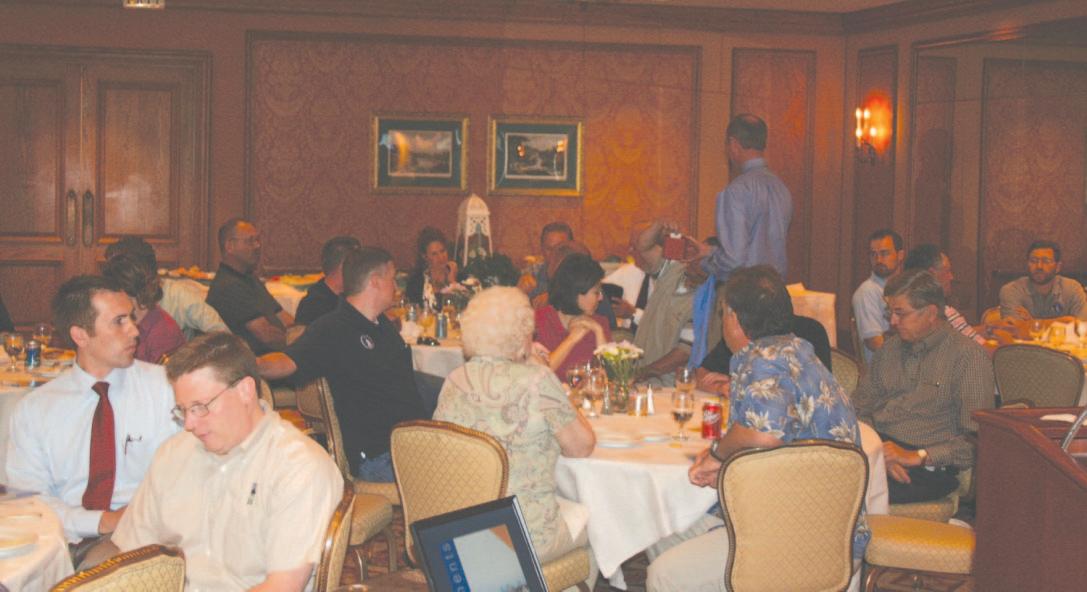
According to PTAC State Director, Fred Lange, outreach meetings structured in a similar way as the Boeing event have been scheduled on the average of one per month—with companies including Northrup Grumman, Booz Allen Hamilton, MCT, General Dynamics, Lockheed, Jacobs Carter & Burgess, to mention a few.
Chuck Spence, Deputy Director of the Statewide PTAC Program, initiated a Teaming Agreement between two PTAC clients, E-CORP, Tooele, and Intermountain Rigging and Heavy Hauling (IRH), Salt Lake City, to team on the Hill Air Force Base 309th Equipment Support Solicitation. IRH fills a niche that E-Corp needs, because IRH’s revenues exceed the $6.5 million threshold for this solicitation, IRH is unable to bid as a prime. Therefore, PTAC introduced IRH to E-CORP and a Teaming Agreement was reached, along with non-disclosure agreements.
The second annual Procurement Symposium held in 2007 at SouthTowne Expo Center, Sandy, saw 725 attendees learn how to sell to the Government and Military, and heard a motivating and encouraging keynote speech from Governor Huntsman. Don Cazel, the top civilian position at Hill AFB was a speaker as well and shared with the large audience that Hill expects to continue its growth and therefore its ability to be a very significant contractor with Utah’s companies that have products and services to sell to the Air Force.
Governor’s Office of Economic Development • Annual Report 2008 32
RURAL DEVELOPMENT
The Rural Development Program is an advocate and support provider to Utah’s rural communities and businesses and is the conduit for rural Utah to other GOED and State resources.
GOED Partners
Through partners like the Governor’s Rural Partnership Board, with representation from business, industry, government throughout the state, the GOED Rural Office educates and raises awareness about rural needs. The office also helps to define economic barriers, and bring these issues to light with the Governor, the Utah Legislature and other state and federal agencies.

USU Extension has partnered with GOED in many seminars and workshops, and coordinated programs. Quarterly the Rural Office hosts a statewide internet Webcast. Topics have centered around business and economic development ranging from brownfields, entrepreneur and small business development to open space preservation.
The Rural Office continues to support the statewide network of local economic development professionals and has partnered with Center for Rural Life, Cedar City, to support the annual Rural Summit. Outreach services continue to be formed with Utah Department of Community and Culture, the Governor’s Office of Planning and Budget, custom fit training, manufacturing partnership, the Utah Alliance, clusters development, business recruiting, incentives and USTAR.
Energy will ever be important for Utah and the nation. The rural office has worked closely with state and local governments and industry to address issues in the field of energy development.
Business and Economic Development Assistance
Industrial Assistance Fund’s Fast Track incentives are available to non-retail business in eligible rural counties. These companies must have been in business for a least 2 years and have at least 2 employees. Incentives are to assist with new infrastructure investments and costs of new employees. So far this year, businesses in Carbon, Emery, Garfield and Sanpete Counties have received incentives from this fund. For a detailed listing please see page 24.
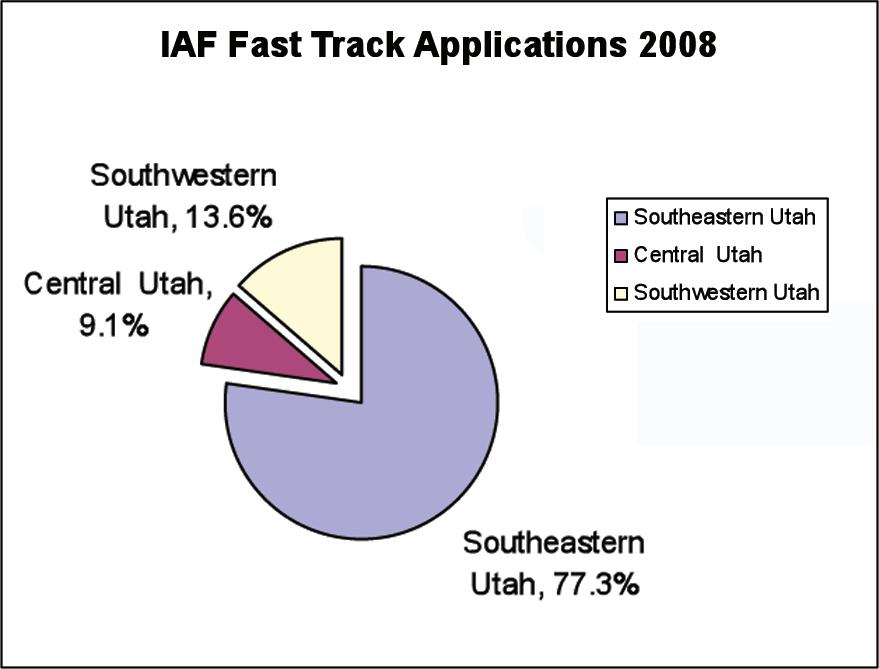
Business applications have been received from a wide range of rural locations as shown in the above chart.
Governor’s Office of Economic Development • Annual Report 2008 33
Georgia Pacific Plant in Sigurd, Utah.
RURAL DEVELOPMENT
Utah Enterprise Zones allow non-retail businesses, with operations in locally defined and state approved geographical zones, tax credits for new investment in plant and depreciable equipment. Credits are also given for creating jobs, rehabilitating older facilities and providing health benefits.
Recycling Market Development Zones allow limited Utah state income tax credits for the purchase of equipment and operation expenses in recycling operations and for manufacturing with recycled content feedstock. Composting is also an eligible activity. Over the last 12 years this industry has averaged an annual investment of over $17M.
Rural Development Grants are available to communities to facilitate economic development projects and are generally used to match other funds. Four projects were funded during the 200708 fiscal year.
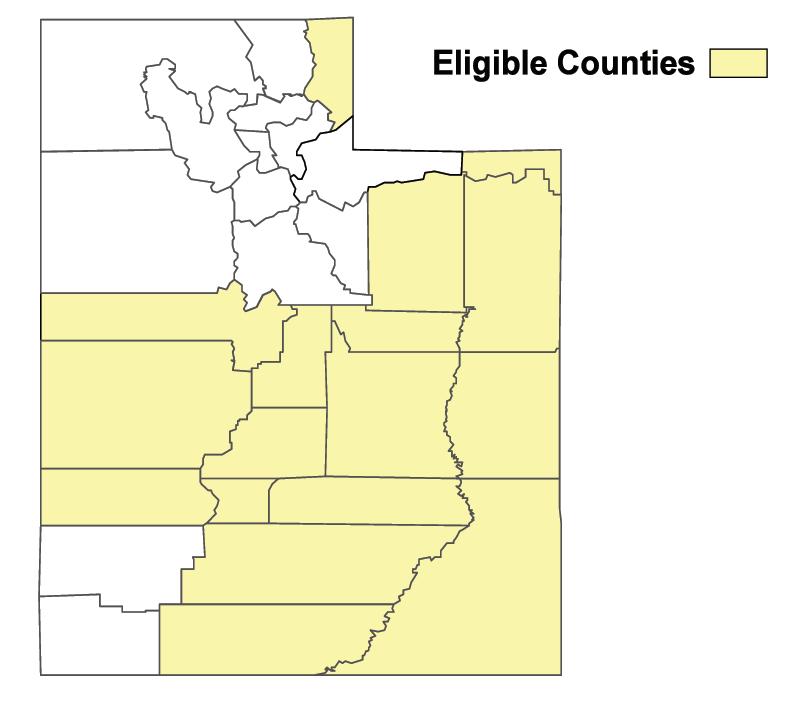
•Dow ntown Western Vision and Overlay Zone – Kanab, Kane County
•Business Visitation Initiative – Southeast Region
•Ar ts Studio/ School – Helper, Carbon County
•Aquaculture Industry Revitalization – Wayne County (picture in file)
Infrastructure
Most of rural Utah continues to grow in population and in economic activity. Average population growth is about 1.4% per year, with job grow th at 5.5%. Infrastructure is critical to all ru r al growth and development. Last year GOED assisted four telecommunication companies expand broadband into many rural regions where broadband did not exist. The areas included Glenwood, Mona, Columbia, Kenilworth, Sigurd, Venice, Grouse Creek and Pleasant Valley. Please see page 25.
Frontier Communication is preparing to install fiber optic cables in Southeastern Utah from Moab to Blanding and possibly beyond. Qwest already has redundancy to Moab.

Governor’s Office of Economic Development • Annual Report 2008 34
Eligible Counties for Rural Development Grants and IAF Fast Track.
Main Street Panguitch, Utah.
STATE SCIENCE ADVISOR
Overview
The State Science Advisor (SSA), appointed by the Governor, provides advice and counsel on science and technology issues to the Governor, state legislature and other state agencies. The Science Advisor serves on a broad range of boards and commissions pursuant to the oversight of key scientific initiatives, research efforts, federal and state mandates and on-going programs devoted to science and technology issues. The Science Advisor has specific responsibility to supervise or participate in the following key areas.
Adv isory Council on Science and Technology (SAC)

The SSA and SAC review significant advances in science and technology and advise and make recommendations to the Governor, state legislature and governmental agencies on the use of science and technology to foster scientific literacy and to strengthen the state’s economy, educational system and quality of life. The SSA serves as an ex-officio member of the SAC and provides staff support for all SAC activities and initiatives. This year the SAC solicited and reviewed 33 nominations for the Governor’s Medal for Science and Technology. The dinner was held at the Clark Planetarium in January with over 200 attendees. Dr. Scott Sampson, a renowned paleontologist, was the emcee for the event, with Governor Huntsman presenting the awards to the eight awardees. The Governor’s Medal is a symbol of recognition for those individuals who have provided distinguished service in the fields of science and technology. The Governor’s Medal recognizes outstanding achievement in the following areas: academia, industry, government and education. The SAC also appointed three new members this year: Larry Madden, Lyman Frost and Tim Wood.

Utah Applied Science, Technology and Engineering Camps (ASTEC)
The SSA supports a state-wide science camp initiative that provides opportunities for students to become involved in hands-on science, technology and engineering activities. This year the ASTEC program supported 18 camps, with over 800 participants projected for the camps. Participants are represented from the entire state of Utah, with five being offered in rural areas of the State. The Science Olympiad is one of the two camps that focused on bringing innovative, hands-on science education training to public education science teachers. The intended outcome of the camp was
Governor’s Office of Economic Development • Annual Report 2008 35
Crime Scene Investigation at the Granite Tech Institute summer camp.
Teachers observing a rocket being blasted at this year’s Weber Teachers Science Olympiad.
STATE SCIENCE ADVISOR
to help science educators (20 participants in total) implement their own Science Olympiad competitions for their students. This is the second year for the Science Olympiad and the result for last year’s camp had 11 of the 15 teachers bringing teams to the 2008 Science Olympiad; one of these teams placed 2nd (out of 21) in the High School division and another placed 3rd (out of 24) in the Middle School division for their first year of competition. A new grant was awarded to the City of South Salt Lake to offer a Crime Science Investigation (CSI) camp to at risk middle school students at Granite Peak Middle School. The grant will serve 40 students and collaborate with two other ASTEC awardees to share curriculum materials, laboratory space and teaching experience. The Davis Applied Technology Center will be offering two camps that help to recruit students into career paths in advanced composites. This is exciting as it truly connects to workforce development for the State.
Financial support for ASTEC was a result of legislative funding ($150,000) and the awards were given as a result of a competitive application process.
Workforce Innovations in Regional Economic Development (WIRED)
GOED recently received a US Department of Labor grant for $5.1 million through the Workforce Innovations in Regional Economic Development (WIRED) program. This 3-year grant focuses on supporting the Utah Life Science industry by building strong partnerships through government agencies, higher and public education institutions, Life Science industries and community and philanthropic entities. There are eleven partners, including higher and public education, government, community/philanthropic and industry whom will work together to create outreach and recruitment activities, as well as education and training programs that support the Life Science industry in Utah. An example of an activity is the partnership between Utah Valley University (UVU) and Salt Lake Community College (SLCC) to create the first 4-year degree in Biotechnology. The first phase of this project was implemented in Fall of 2007 at the SLCC Jordan Campus to offer the junior and senior year of the new BS in Biotechnology for 2-year SLCC transfer students. Currently 10 students are enrolled in the program. The full, 4-year Biotechnology degree will be offered at the UVU campus for incoming freshmen. Currently there are 38 declared Biotechnology majors that will begin their program in Fall of 2008. This not only represents exciting new career and education opportunities for students, but also helps to provide a well-qualified workforce for Utah Life Science companies.
Governor’s Office of Economic Development • Annual Report 2008 36
UTAH OFFICE OF TOURISM
The Utah Office of Tourism brands and promotes Utah’s great experiences for visitors and citizens in a way that enhances our quality of life. More v isitors are coming to Utah than ever before, since the Governor’s Office of Economic Development’s Utah Office of Tourism launched the “Life Elevated” brand in April of 2006. Last year, more than 20 million v isitors were attracted to Utah’s five national parks, more than 40 state parks, 13 world-class ski resorts, recreation areas, historical sites, and other major attractions. Governor Huntsman’s administration is committed to enhancing Utah’s national and international image and promoting the state as a year-round destination. The 2007 summer marketing campaign included national cable television, print, and online advertising, as well as market-specific advertising in Denver, Phoenix, and Los Angeles. The 200708 winter campaign focused on the Los Angeles market, and a national cable buy. Each campaign produced a substantial return on investment, earning $17.14 and $13.65 for every dollar spent respectively. Utah lawmakers have appropriated $11 million dollars for out-of-state advertising and co-operative marketing for the upcoming year.
Hig hlights

•The first version of utah.travel was launched in spring of 2006 as a portal to the State’s Tourism Web site. In March of 2008, the site was expanded and launched as a lure piece with added features such as the online Utah Travel Guide, interactive content, and partner links.
•The office acquired, distributed, and shared a new collection of over 14 hours b-roll video footage, highlighting many key locations and events around the state.
•Delta Air Lines launched non-stop service from Salt Lake City to Paris, June 2, 2008. UOT, working w ith Delta, promoted the state and the new flight in the UK, Germany, and France. Also, promotional meetings with over 300 travel agents and tour operators were held in Paris.
•The cooperative marketing program allows non-profit entities to expand out-of-state marketing dollars by partnering with the Utah Office of Tourism. UOT matches qualified applicant’s marketing dollars up to $250,000. In fiscal year 07-08, UOT received 48 applications requesting $2.5 million. The Board of Travel Development funded 43 applications for $2.25 million.
•The Madden Preprint campaign, a newspaper advertisement insert project done in cooperation with 23 instate tourism partners, has resulted in 243,576 leads to date, the most in Madden’s history.
•The Utah Travel Guide received the Mercury Award, the highest award for excellence given at the annual Travel Industry Association conference. The guide was updated w ith a fresh look and new content. To date, UOT has distributed over 190,000 of the new guides, and it has been viewed 16,641 times since it came online in March 2008.

Governor’s Office of Economic Development • Annual Report 2008 37
Governor Jon Huntsman in Southern Utah. 2008-09 Travel
Guide
UTAH OFFICE OF TOURISM
•The 2008 Utah “Life Elevated” Scenic Calendar was honored with six awards in the National and World Calendar Awards competition, hosted by the Calendar Marketing Association.
•T he One-Sheet Recreational Information series was given an updated look and the text was refreshed. The Top of Utah and Scenic Byways topics were added, as well as French and Chinese editions.
•Travel information kiosks were placed at five state and local Welcome Centers. They feature lodging, restaurant, and activity information in 14 languages.
•UOT has seats on the following partner committees: Ski Utah Marketing and PR, Canyon Country Partnership, Cultural Heritage Council, SLCVB MPI Steering Committee.
•Council Hall Welcome Center was updated and redesigned with all new signage.

Seven regionally-specific “Welcome to Utah” signs were designed and are being placed at 31 entry points into the state.
•UOT ’s scenic byway coordinator met w ith organizations and other partners throughout the year to build communication and coordination. In December, Utah byways programs were awarded $345,878 in grants. In January, Utah submitted 14 grant requests totaling $1,122,264 for federal funding.
•This year, UOT has conducted 60 FAM Tours for 276 qualified trade and media representatives (249 participants) to experience Utah. As a result of media visits, UOT has received copies of some 276 articles that represent an approximate media value of $3,625,255.00.
•The Utah Office of Tourism has aligned its international marketing efforts with those countries that the Department of Commerce has listed as generating the most tourists inbound to the U.S: Canada, Mexico, United Kingdom, Japan, Germany and France.
•Multi-Language Travel Guides (French, Queen’s English, German, Spanish) were designed and published.
•For 2008, Utah published ski product in Germany is up 29%. The number of tour operators promoting skiing in Utah increased from 17 companies in 2006 to 22 companies in 2007.
•UOT coordinated the state’s representation at the following international travel trade shows: Go West Summit – International, ITB – Berlin, World Travel Market – London, CITM – China, Pow Wow – International, Top Resa – France, UTRA Consumer Shows – US, Addison Travel Shows –Canada, JATA – Japan, Paris Business Trade Mission.
•UOT had booth presence at the following domestic shows: Utah Travel Regions adventure consumer shows, Go West Summit in Colorado Springs, National Tour Association Convention in Kansas City, Sunset Magazine Celebration Weekend in San Jose.
Governor’s Office of Economic Development • Annual Report 2008 38
UTAH OFFICE OF TOURISM
FY2007-08 Strategic Marketing & Research, Inc., Study
•The Utah Office of Tourism’s Summer 2007 advertising campaign helped to generate $851 million in traveler spending and $67.7 million in state and local tax revenue, generating a return on investment (ROI) on state and local tax revenue of $17.14 for every $1 spent on the ad campaign.
•The Utah Office of Tourism’s Winter 2007-08 advertising campaign helped to generate $391.7 million in traveler spending and $29.7 million in state and local tax revenue. The return on investment (ROI) on state and local tax revenue was $13.65 for every $1 spent on the ad campaign.
Tourism by the numbers:

•County Transient Room Tax Revenue: $34,602,624 (Increase of 23.55%)
•National Parks Visits: 5.4 million
•National Monument Visits: 2,096,666
• State Park Visits: 4.4 million
•A fifth record-breaking season saw 4.25 million skier days
•Vehicles entering Utah through Interstate Highways: 23,920,275 Million
•Passengers landing at Salt Lake International Airport: 21.7 million
•Utah.travel visits: 154,388
•Welcome Center Visits: 497,012
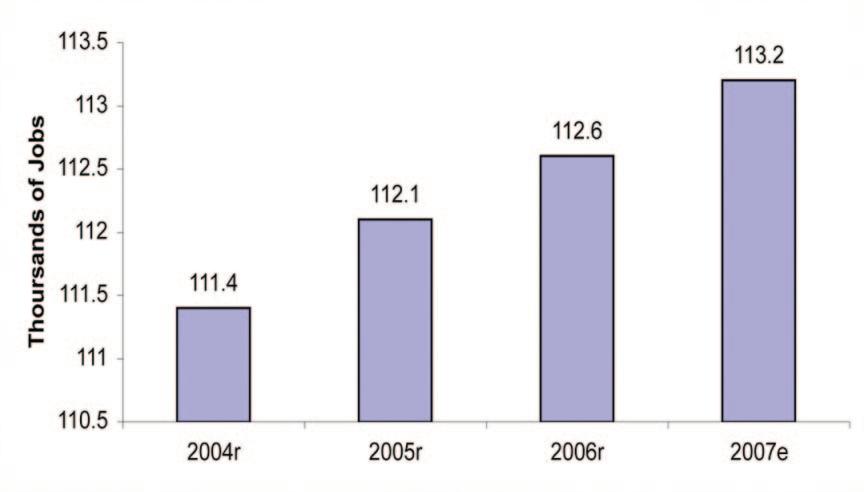

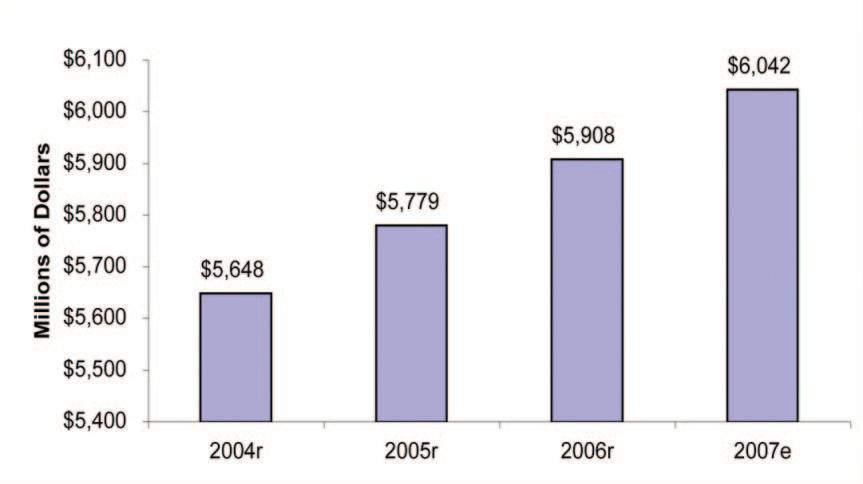
Governor’s Office of Economic Development • Annual Report 2008 39
UTAH RECRUITMENT INITIATIVE
Growing Utah’s Economy by providing needed talent to Utah companies It has been two years since Governor Jon Huntsman tasked the Governor’s Office of Economic Development to strengthen workforce recruitment and talent acquisition to the state as a pillar of Utah’s economic development formula with the creation of the Utah Recruitment Initiative (URI). And during that time, as the nation’s economy has slowed and Utah finds itself in the unique position of coming out of a period of historically low unemployment and record high job growth, the Governor’s vision of URI and its purpose has proven beneficial in helping provide another option to Utah companies for finding highly trained job recruits wanting to make their way to Utah.

URI began as a public-private partnership task force that oversaw some of the state’s first foray’s into the national job recruitment market. URI, under GOED’s leadership, has partnered w ith the Department of Workforce Services in bringing together both public, private and non-profit education and economic development groups. This effort assures that Utah’s job pipeline is filled with vibrant employees who have the specialized skill sets and knowledge required of today’s global workforce.
At present, the URI taskforce has numerous resources to assist out-of-state job seekers in finding one of the many available jobs in Utah requiring specialized technical skills that are in high demand. The URI taskforce is also working with Utah companies to make sure they have access to candidate information as well as resources essential to attract candidates to Utah’s unparalleled quality of life and dynamic economy.
The URI taskforce, through www.utahworksforyou.com provides the resumes of more than 2,000 candidates, most of who are living out of state, to Utah companies seeking these individuals. That database of Utah jobseekers is growing at an average of 20-30 new postings a week depending on marketing trends undertaken by URI. Thanks to GOED’s partnership’s with other private and non-profit groups, Utah companies can also request information on more than 18,000 job seekers who have expressed an interest in returning to and working in Utah. The URI website also allows companies to post specific positions to various job boards around the country and also features the more than 26,000 open jobs available in Utah through the Department of Workforce Services.

Through various national media campaigns and robust online marketing utahworksforyou.com has been receiving close to 5,000 visitors a week. Workforce development will remain one of the nation’s top economic development issues for years to come and Utah is making sure it is a step ahead in this area.
The mission of URI is to make sure the message that Utah has plenty of great jobs and continues to add to them is out there, along with being an access point to match that talent with the companies in Utah needing it.
Governor’s Office of Economic Development • Annual Report 2008 40
PARTNERS
Governor’s Office of Economic Development • Annual Report 2008 41
ECONOMIC DEVELOPMENT CORPORATION OF UTAH
The Governor’s Office of Economic Development (GOED) has contracted with the Economic Development Corporation of Utah (EDCUtah) to handle the state’s business recruitment efforts. Today, a strong partnership has been created with significant coordination and success in recruiting businesses to Utah. This partnership now links state government with local government and the private sector in a unified approach to business recruitment.
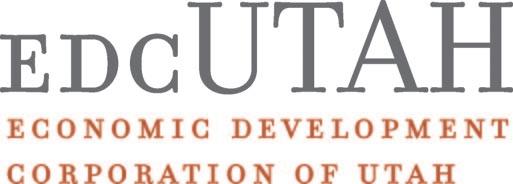
EDCUtah is an investor-based public/private partnership working with government and private industry to serve as a catalyst for quality job growth and increased capital investment. EDCUtah assists in-state companies to grow and recruits out-of-state companies to expand and relocate in Utah.
PROCTER & GAMBLE CO: ONE OF MANY RECRUITMENT SUCCESS STORIES
Recently many companies have found success by relocating or expanding to Utah. Procter & Gamble Co. is a prime example of the quality of companies that are making their way to Utah.
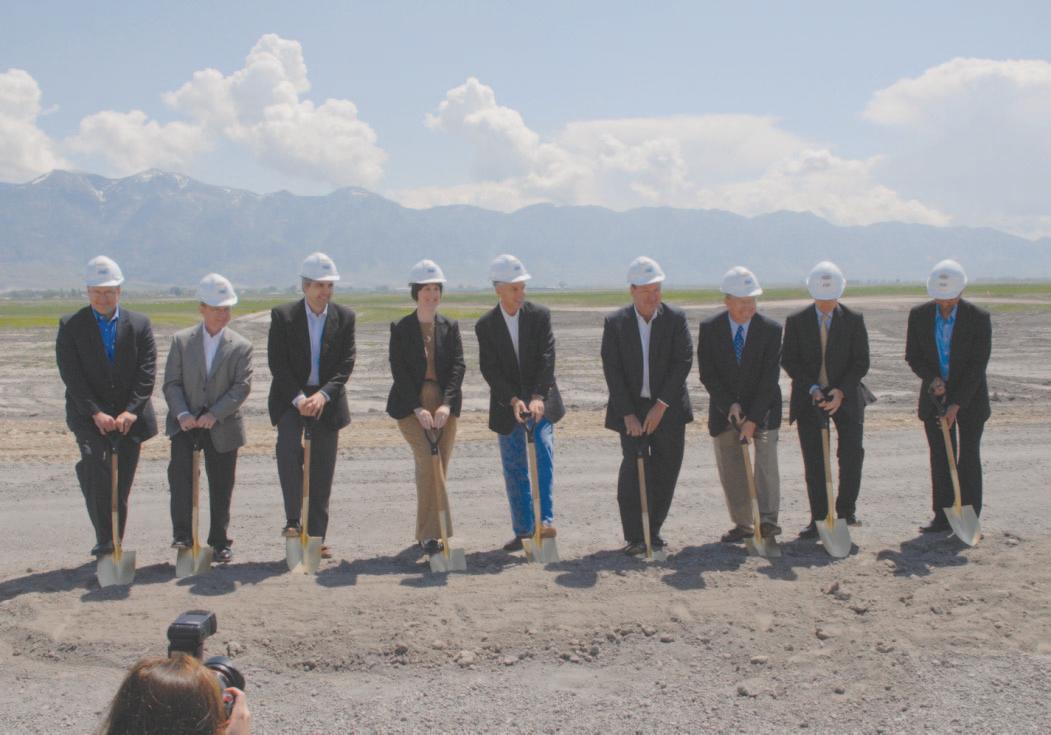
Procter & Gamble Co., the world’s largest consumer products company, is building its first domestic greenfield manufacturing site in 34 years in Box Elder County. Over the length of the project the company will spend approximately $540 million dollars and will employee more than 1,000 people.
GOED worked in partnership with EDCUtah, Box Elder County, Questar, Rocky Mountain Power, and Union Pacific to provide information, incentives, power, transportation access, and assistance to Procter & Gamble Co. as the company narrowed its decision down to Utah. Many individuals from the community and private business sector came to the table to assist and show support for the project and to the company. It was truly a partnership effort.
RESULTS
EDCUtah’s involvement in expansion and relocation projects generally includes many elements including gathering and consolidating critical economic data, preparing sophisticated economic analyses, organizing and hosting meetings and site visits, connecting clients with key government and private sector individuals and departments, facilitating discussions and negotiations, and helping clients through the entire relocation/ expansion process.
Governor’s Office of Economic Development • Annual Report 2008 42
Procter & Gamble ground breaking in Box Elder County, May 2008.
ECONOMIC DEVELOPMENT CORPORATION OF UTAH
During the 2007-2008 fiscal year, GOED and EDCUtah assisted the following companies that subsequently announced intentions to expand or relocate in Utah.
• FiberTEK Insulation, LLC
• Thermo Fisher Scientific Inc.
• Barnes Aerospace
• U.S. Foodservice, Inc.
• Children’s Miracle Network
• Procter & Gamble Co.
• Southern Classic Food Group
• CSS – Cybernet Slash Support
• Heritage Bag Company
• Interline Brands, Inc.
• FedEx
• Hershey Company
• Sephora USA
• Malnove
• PolyExcel, LLC
• Oracle
• Goldman Sachs
• Schreiber Foods
• Cementation USA
• Cryomed
• US Magnesium LLC
• Million Air Salt Lake City
• Young Electric Sign Company
• Army Reserve
• Air Liquide
• Avalanche Software/Fall Line Studios
The following metrics are a result of the efforts of the GOED / EDCUtah partnership during the 20072008 fiscal year:
• 26 companies relocated, expanded, retained.
• 5,370 new jobs committed.
• 867 jobs retained (from companies that had been considering leaving the state).
• 2,617,590 square feet of real estate absorbed.
• $1.3 billion of new capital investment in Utah.
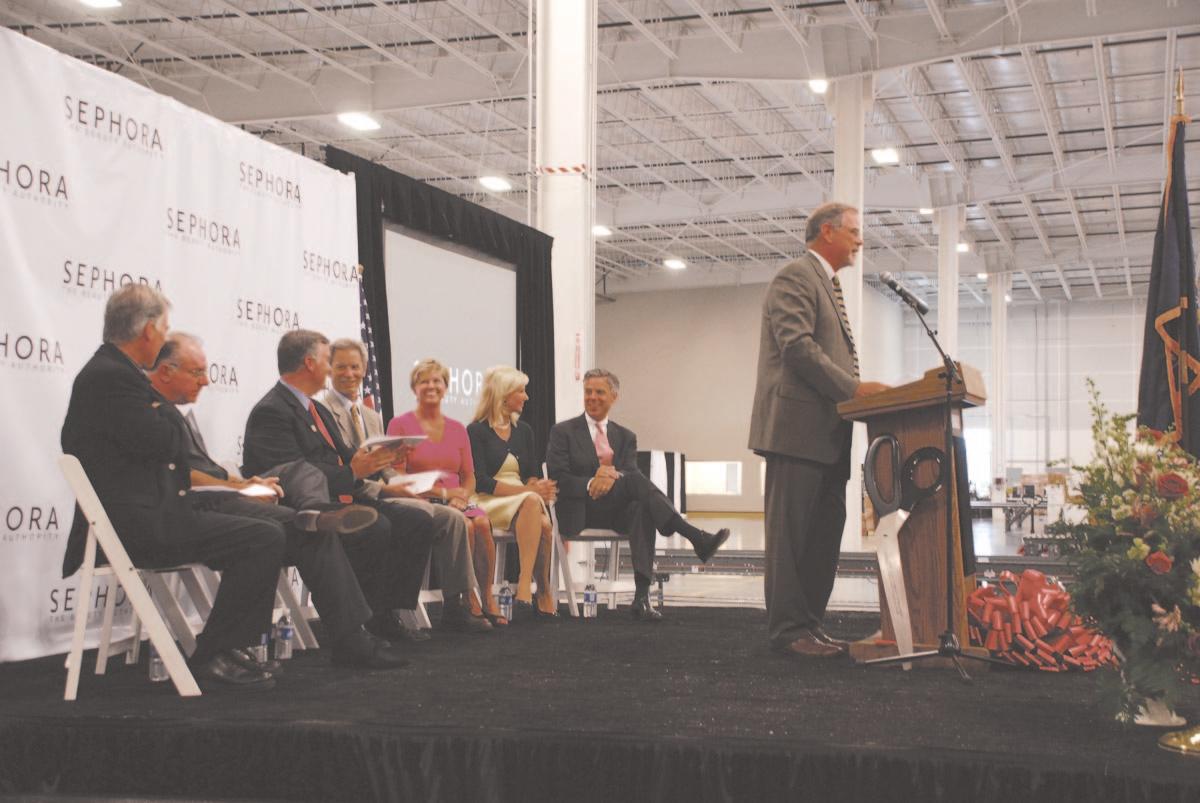
Governor’s Office of Economic Development • Annual Report 2008 43
Sephora Ribbon Cutting in Salt Lake City, August 2008.
UTAH FUND OF FUNDS
The Utah Fund of Funds (Utah FoF) is a major economic development program created by the Utah Legislature to provide the state’s entrepreneurs with access to a broad array of quality funding sources. With an initial charter of $100 million approved in 2003, the fund invests in quality venture capital/private equity firms, which in turn explore investments in promising Utah entrepreneurial growth companies. In the 2008 session, the state legislature augmented the program with an additional $200 million.

As of July 2008, more than 200 funds had applied to the Program, from which 20 high-quality venture capital/private equity firms had been selected as portfolio firms, including seven from Utah. Partners at outof-state firms commit to spend a predetermined amount of days in Utah, helping that fund build a strong network of Utah business leaders, entrepreneurs and companies.
“I’m glad to hear of the increased investing activity being fostered by the Utah Fund of Funds. More competing VCs improve practices and the treatment of entrepreneurs, helping the entire ecosystem reach a healthy balance that can only be created through a free market with numerous funding sources competing.”
Josh James, CEO/Co-founder, Omniture
Success
Thus far in the program, Utah FoF portfolio firms have completed 359 in-depth reviews of Utah companies and selected 25 to receive funding. Over $127 million has been invested in these companies, and the portfolio firms have helped them raise an additional $365 million through further syndication. Most importantly, these 25 companies have created a total of 1,006 jobs, with an annual average salary of approximately $60,000—far above the Utah average wage.
Utah’s information technology and biosciences sectors have enjoyed significant growth and heightened interest with the help of the program’s impact on both early-stage and growth-stage companies. In addition to providing enhanced access to a greater number and diversity of funding sources, Utah FoF works directly to match the state’s entrepreneurs and growth companies with appropriate VC/private equity firms and business mentors.
Select Company Highlights
LineaGen, Inc. (Salt Lake City) – Funding is notoriously difficult for early-stage companies, but even more so for an early-stage company in the biomedical sciences. Utah FoF was instrumental to LineaGen’s success in raising $5.8 million in the midst of a very tough venture capital market for start-up life science companies.
Spectr um DNA. (Park City) – Utah FoF was a key resource in this innovative social media development studio firm raising its initial $3.2 million. FoF provided invaluable counsel and contacts, delivering a host of qualified investors, allowing the company to focus on creating value in the business.
Utah Fund of Funds Snapshot
Program size
Number of portfolio firms
Local companies funded
Funds invested
Additional syndicated funds raised
Jobs created
Average annual
Governor’s Office of Economic Development • Annual Report 2008 44
. . . . . . . . . . . . . . . . . . . . .
.$300 million
. .
. . .
.
. . . . . . . . . .
. . .19
. . . . . . . . . . . . . . . . . . .
.25
. . . . . . . . . . . . . . . . . . . .$127
million
. . . . .$365
million
. . . . . . . . . . . . . . . . . . . . . . . . . . .1,006
. . . . . . . . . . . . . . . . . $60,000
salary
UTAH SCIENCE TECHNOLOGY AND RESEARCH INITIATIVE
Overview
The Utah Science Technology and Research initiative (USTAR) is a long-term, state-funded investment to strengthen Utah’s leadership in the “knowledge economy” and to generate high-paying jobs in the technology sector. Funded in March 2006 by the State Legislature, USTAR is based on three program areas, AllStar Faculty, State-of-the-Art Research Facilities, and Tech Outreach, each discussed within this report.

USTAR is ahead of schedule in attracting leading research talent and supporting their efforts in USTAR’s key Innovation Development areas as summarized in the following table.
New companies under development04
Individual Programs
All-Star Faculty
The first program area involves funding at the University of Utah and Utah State University to recruit worldclass researchers working in billion-dollar markets. USTAR has focused investment in five key Innovation Development areas. This effort is budgeted at $15 million a year.
Governor’s Office of Economic Development • Annual Report 2008 45
ProjectionsActualActual vs. for(Cumulative)Projections CategoryJune 30 ’08 All-star faculty hired1520 133% Research actively underway911 122% External research awards$2.7 mm$9.03 mm 334% Total awards proposedN/A$67.8 mm Ahead of plan
Ahead of plan
Ahead of plan
Ahead
Ahead
Patents filed02
Companies started in Utah01
of plan Companies brought to Utah01
of plan
UTAH SCIENCE TECHNOLOGY AND RESEARCH INITIATIVE
State-of-the-Art Research Facilities
The second program area is building state-of-theart interdisciplinary research and development facilities at both the University of Utah and Utah State University for the innovation teams. State legislators have created a $160 million USTAR building fund which also has a $40 million university match.

The USU building has completed the schematic design phase. Grammoll Construction has been competitively selected as the Construction Manager General Contractor (CMGC) as was AJC Architects as the Architectural and Engineering (AE) firm and design team lead. The facility is slated to break ground in October 2008 and open in 2011. At the U of U, the CMGC and AE will be selected by September 2008. The Design and Construction schedule on the University of Utah facility has yet to be finalized, however, construction is tentatively set to complete in 2012. Both facilities are on schedule.
Tech Outreach
The third program area involves commercialization teams that work with companies and entrepreneurs across the State. The USTAR Technology Outreach Innovation Program (TOIP) is led by regional directors, who oversee centers based at Weber State University, Utah State University-Uintah Basin, Salt Lake Community College, Utah Valley University, Dixie State College and a satellite office at Southern Utah University. The state has dedicated $4 million annually to support TOIP activities.

Whether a business is a start-up trying to grow from $0 in revenue to $1 million, or an established concern trying to grow from $10 million to $50 million or more, the USTAR TOIP team is able to help their efforts. “The USTAR outreach directors all have 15 to 25 years of business experience and have expertise in all the key aspects a new or highgrow th company needs to succeed,” says Central Utah regional director, Steve Roy.
The TOIP team consults with specific companies and entrepreneurs to connect them with new innovations, new markets, sources of capital, human resource talent, and industry partners. Innovators can take advantage of grants and consulting services to strategize markets, prototype products, secure intellectual property, gain access to venture funding, and ultimately connect to USTAR research university breakthroughs. “On top of general business experience, TOIP directors have specific expertise in life sciences, advanced materials, information technology, and, in my case, the energy sector,” says Eastern Utah regional director, Al Walker.
Governor’s Office of Economic Development • Annual Report 2008 46
USTAR buildings on University of Utah and Utah State University campuses will be state-of-the-art when completed.
UTAH SCIENCE TECHNOLOGY AND RESEARCH INITIATIVE
In just 18 months of TOIP activity, USTAR has made impressive progress in building entrepreneurial and innovation capacity statewide including:
Research – USTAR faculty are driving exciting developments, from securing multi-million dollar, energy-related federal grants, to commercialization efforts focused on nano, brain science, and laser imaging technologies.
Helping Small Businesses Win Utah’s Share of Federal Research Grants – Working with partner agencies and stakeholders, USTAR spearheaded the creation of and manages a new SBIR/STTR grant assistance center that opened in June 2008.
Collaboration Platform – USTAR website, www.innovationutah.com offers resources to find complementary research activities, connect innovators with industry, share ideas, and enables access to business management templates.
Suppor t for Investors – USTAR directors worked with regional economic development partners such as SEED Dixie and SEED Weber Morgan Davis. These efforts lead to the creation of two angel investor groups where none existed before, and the re-invigoration of several existing groups.
To date, more than 130 companies have been identified as candidates for engagement, with 32 currently involved in extensive support projects. The following activities have transpired:
• 14 regular recurring consulting engagements
•9 market/opportunity analysis reports
• 11 brokered connections to university resources or industry partners
•8 projects to help product development, prototyping/testing, or patent research
•6 client presentations to angel investor groups
In closing
Some states have programs to recruit all-star faculty, or build research facilities, or provide technology outreach, but few have all three program areas combined under one executive structure. This three prong approach allows USTAR the nimbleness and flexibility to address the complete needs of the state as a whole.
USTAR is ahead of plan on measurable results, and are making significant progress on all fronts. Research teams are forging ahead, and USTAR directors are driving economic growth across Utah.
USTAR research focuses on five Innovation Areas:





Energy Biomedical Innovation
Brain Medicine
Digital and Imaging Technologies
Personalized Health
Governor’s Office of Economic Development
Annual Report 2008 47
•
A Rich Portfolio of Innovation
UTAH SPORTS COMMISSION
The Utah Sports Commission is working to distinguish the State of Utah as a leader in the world of sports marketing, event attraction, sport development and sport-related tourism. The Sports Commission is continuing to exercise fiduciary responsibility in allocating public and private funding to sporting events as it promotes the State of Utah and generates economic impact through sport.
In 2007-2008, the Sports Commission partnered in 46 worldclass sporting events across the state and leveraged those events where advertising or sports tourism activities could be executed. $1.6 million in funding was provided to sports events resulting in an estimated $132 million in economic impact to the State of Utah and a return on investment of $82 per $1 spent. A number of these events hosted also had a major national and international television component to them generating an estimated $10 million in media value to the state.
The Utah Sports Commission continues to contribute building the state’s annual $4.5-6 billion dollar sports industry through capitalizing on its core competencies, including winter sports, action/adventure sports, golf, motor sports, Olympic legacy sports and activities, and others.
Utah’s 2007-2008 Key Sporting Events

TELEVISED EVENTSNON-TELEVISED EVENTS
Jeep King of the Mountain Mt. Biking World ChampionshipsTriple Crown Fastpitch Softball World Series
Utah EnergySolutions ChampionshipXTERRA Mountain Championship
AST Dew Tour Toyota ChallengeSorenson’s Champions Challenge
FIS Freestyle International World CupHuntsman World Senior Games
World Superpipe ChampionshipsEssent ISU World Cup Speedskating
XTERRA Winter World ChampionshipU.S. Junior Figure Skating National Championships
U.S. Freestyle ChampionshipsLuge Junior World Cup
FIM Superbike World ChampionshipsU.S. Ski Jumping & Nordic Combined Championships
STIHL Timbersports SeriesSalt Lake City Marathon
Ride Guide TV Utah Mountain BikingSt. George Triathlon
Ogden Marathon
Ragnar Relay Wasatch Back Grand Prix American Le Mans Series
Governor’s Office of Economic Development • Annual Report 2008 48
The Dew Tour came to Utah in 2007 and 2008.
Impact on the State of Utah
Utah’s Sports & Recreation Industry Annual Economic Impact
Approximately $4.5 - 6 Billion**
Utah’s Sports & Recreation Industry Annual Tax Revenue to Utah
Over $300 Million**
Utah’s Sports & Recreation Industry Utah Jobs
Over 65,000**
Economic Impact from Hosting Events 2000-2011***
Approximately $830 Million
Return on Investment (ROI) from Events Hosted
$82:$1
• Total State Money Received for Events from ‘99-‘08 — $8.67 Million
• Total Impact from Events Hosted and/or Committed — $830 Million
• Relocated US Speedskating to Utah
Non-State Funds/Value-in-Kind Raised and/or Leveraged to Enhance State-wide Sports Development Efforts
Approximately $7.3 Million



Events Landed or Partnered with “TEAM UTAH*” 2000-2008 278
• Including events committed thru 2011

* TEAM UTAH consists of all entities working with the Utah Sports Commission to impact the state through sports & recreation
** University of Utah study and Outdoor Industry Association study
*** Committed resources to secure World Championship freestyle event in 2011 (See updated Economic Impact formula)
Governor’s Office of Economic Development • Annual Report 2008 49
UTAH SPORTS COMMISSION
UTAH SPORTS COMMISSION
Impact on the State of Utah
Cities and Counties Impacted through Sport Development in Utah
Heber City, Ephraim, Logan, Ogden, Weber County, Salt Lake City, Kearns, Sandy, West Jordan, West Valley City, Provo, Orem, Lehi, Moab, St. George, Washington County, Monument Valley, Tooele, Park City, Murray, Brian Head, Davis County 22
Events Received Funding/Grants
163
Event Inquiries 2000-2008
Over 850
Value of Media Exposure for Sports Events Held in or Associated with Utah 2007-2008
Estimated $10-$12 Million in value
Value of National/International Television from Events Hosted 2000-2008
Estimated $20-22 million in value
Grants, Marketing, Advertising and Tourism
Related Promotion of Utah Sport Brand Utah: The State of Sport - Cash and VIK
Approximately $5.770 Million
Manage TEAM 2002 Olympic Volunteer Legacy Database
Approximately 10,000
Manage Utah’s Only Official PGA TOUR Golf Event
20 Hours of TV Coverage with Utah Promotional Ads and an Estimated Economic Impact of Over $4 Million




Governor’s Office of Economic Development • Annual Report 2008 50
SMALL BUSINESS DEVELOPMENT CENTERS (SBDC)

The Utah Small Business Development Center (SBDC) is a partnership of the Governor’s Office of Economic Development (GOED) and Utah colleges and universities around the state, with funding in part through a cooperative agreement with the U.S. Small Business Administration.

GOED plays a critical role in funding the Utah SBDC program statewide, providing over 20% of the overall program funding, supporting and directing development of the program, and providing the framework for collaboration statewide, especially in rural communities. Rural priorities include supporting market and industry research for rural businesses, helping focus on outreach with an emphasis on small business expansion, reinforcing the need for rural outreach partnerships, including the new USU Extension outreach collaboration with the Utah SBDC program.
Utah SBDC Vision: To be the most respected and demanded resource for entrepreneurs to turn to for business guidance and education.
Mission: The mission of the Utah SBDC is to strengthen Utah’s economic fabric and quality of life by facilitating the success and prosperity of business endeavors.
The Utah SBDC serves the following clients:
•Individuals who are already in business and need help solving a business problem. Most frequent topics are: accounting, marketing, research, business plans, budgeting and management/operations.
•Company owners and managers who need help in their efforts to expand and grow.
•Company owners and managers looking for specialized training opportunities such as HR, accounting, etc.
•Minority and disadvantaged existing and pre-startup clients.
•Pre-startup clients interested in assessing the feasibility of a business idea.
Success Stories:
Guy Collett
Guy Collett started working with the Uintah Basin SBDC in November of 2003. In the summer of 2004, with the help of the SBDC, Guy purchased his first assisted care facility, a small facility that had previously been used as an assisted care facility.

Soon after opening that first facility, Guy was again visiting the Vernal SBDC for help with accounting, payroll tax and a strategic plan to build a second, new facility. Part of that plan was to use the original facility as the base for income and the new facility for overflow, as the pricing would need to be higher due to increased expenses. Once the original facility was operational Guy could see the need and potential as the population ages. While helping with Vernal assisted care facility.
Governor’s Office of Economic Development • Annual Report 2008 51
SMALL BUSINESS DEVELOPMENT CENTERS (SBDC)
advice on the day to day operations questions, the Ver nal SBDC also helped Guy put together a new business plan and financial projections, and supplied advice on presentations to chambers of commerce and financial institutions. The SBDC worked closely with Guy and his Certified Public Accountant to make sure everything was correct and would give the bankers the proper impression of this business’s potential.
In the fall of 2006, with partial financing secured, Guy broke ground and began construction on the new facility. After securing the remaining financing in late 2006 and early 2007, construction proceeded and the new center was open for business in fall of 2007 with the creation of 8 new jobs.
No r thern Utah Academy of Spanish – South Ogden
The Northern Utah Academy of Spanish (NUAS) was formed in the fall of 2003 as a sole proprietorship and was officially incorporated in January 2005. Trenton L. Maw, President/Director of NUAS is the sole founder and owner. He holds a Ba ch el or of Foreign Language – Spanish and Master of Business Administration degree.

To quote Trenton: “I scheduled an appointment w ith Beverly King at the Weber State office of the SBDC. We discussed the business plans and she helped me to crunch some of the numbers to see how my plan looked. The interesting thing is that the numbers looked difficult to manage on paper, but I believed that I could make it work. I learned about some other resources like SCORE and talked w ith a member of the SCORE team in Ogden who gave me some additional insights. I attended a symposium and various seminars over the next couple of years including legal and marketing topics.”
“In 2007, I reconnected with Beverly King and also met Steve Cloward and Brent Meikle at the Davis Applied Technology College who all have great experience and insights that have helped me. During this time I started to work more closely with Beverly on forming a more complete and solid business plan. We started to work w ith the High Performance Entrepreneur system which has given us some very important insights into what I need to work on first. I anticipate this being a process that will take some time, but may very well be one of the keys to reaching for heights that were previously not even in sight.
“I’m currently considering options to fund the launch of a national marketing campaign that will carry us for ward, and Beverly has been extremely helpful in helping me fine tune my business plan and look at funding options. However this turns out, I’m confident that the route I take will be based on good judgment with the help of the local SBDC.”
Governor’s Office of Economic Development • Annual Report 2008 52
Clients in Business 46% Other Clients 17% Minorities Served 12% Military & Veteran Clients 9% Hispanic Origin Clients 9% Disabled Clients 7%
Utah SBDC Client Demographics
SMALL BUSINESS DEVELOPMENT CENTERS (SBDC)
Utah SBDC Host Institutions:
Utah SBDC host institutions include: College of Eastern Utah (Blanding & Price), Davis Applied Technology College (Kaysville), Dixie State College (St. George), Salt Lake Community College (Statewide Host & Sandy), Snow College (Ephraim), Southern Utah University (Cedar City), Utah State University – Extension (Logan & Vernal), Utah Valley University (Orem), and Weber State University (Ogden).
Statewide projects:
Mentor-Protégé Program at Snow College – The SBDC at Snow College has worked as a Department of Defense Mentor-Protégé Program Partner with Bell Helicopter (mentor firm) to assist a small but rapidly grow ing protégé firm. Thus far, assistance from the SBDC has been focused on three critical objectives: planning, business process improvement, and financial systems. These are part of a three year assistance plan.
Ready Your Business (RYB) is a joint venture with the Utah Division of Homeland Security working to create online training to help prepare small businesses for disasters that force thousands of businesses to close each year. http://beready.utah.gov/business.html.
The Business Expansion and Retention (BEAR) partnership program originally began in Carbon and Emer y Counties during January 2006 and continues today. The partnership of Price City Department of Workforce Services, Price Small Business Development Center, Carbon and Emery County Economic Development Departments, State Vocational Rehabilitation, College of Eastern Utah SBDC in Price, is critical to its success in both outreach and resolution of issues. The key to the program is the direct response of the partner agency to the business as identified in the outreach process rather than referring the businesses somewhere else for assistance.
Ver nal SBDC is working closely with (and is a part of) the USU Cooperative Extension on Rural Outreach Centers. This partnership was created in response to GOED’s request that the USU Extension become more involved with economic outreach. Demographics:
Governor’s Office of Economic Development • Annual Report 2008 53
Utah SBDC
of Impact Total Hours of Counseling . . . . . . . . . . . . . . . . . . .9,133 Total Clients Served . . . . . . . . . . . . . . . . . . . . . . . .2,103 Average Counseling Hours Per Client . . . . . . . . . . .4.34 Jobs Created or Saved . . . . . . . . . . . . . . . . . . . . . . . .714 Business Starts . . . . . . . . . . . . . . . . . . . . . . . . . . . . . .256 Loans Obtained . . . . . . . . . . . . . . . . . . . . . . .26,410,000 Equity Investment . . . . . . . . . . . . . . . . . . . . . .7,090,000 Total Capital Infusion . . . . . . . . . . . . . . . . . .33,500,000
Summary
MANUFACTURING EXTENSION PARTNERSHIP (MEP)

The Manufacturing Extension Partnership (MEP) serves Utah’s largest industry sector, Manufacturing. Established by Congress, MEP Centers are located throughout the U.S. and are affiliates of the National Institute of Standards, U.S. Department of Commerce. MEP Utah is a contract partner with GOED which administers state funding for the MEP program. The MEP Utah Center is located at Utah Valley University.
Chartered to assist small and medium-sized manufacturers (<500 employees), the MEP potential service base includes 99% of the manufacturers in Utah. There are more than 3,000 manufacturers in Utah with only 39 employing more than 500 people. However, unlike Agriculture Extension Services MEP has more limited resources and less than 5% of the manufacturers have access to MEP in any given year. Those that are assisted by MEP report significant results. A study of the economic impacts of MEP of Utah prepared by Utah State University shows that MEP served 399 total companies in 2007. Major projects assisted 65 companies reporting measurable impacts. The USU study concluded MEP’s impact on the Utah economy to be:
•Additional Industrial Output – $241.6M
•Additional Indirect Business Taxes – $6.5M
•Additional Wages – $60.5M
•Additional Jobs – 1,462
The nature of manufacturing in Utah is diverse, entrepreneurial, and falls under the classification of “small business”. Yet these small companies have large impacts on the state’s economy. Manufacturing provides significant employment with an industr y payroll over $5.6 billion, which is $1.8 billion larger than the next industry sector and 3 times the average of the remaining 18 sectors.
Even though manufacturing employment in Utah is growing, further analysis raises areas of concern. Each of the following shows a small, but steady decline:
•Utah’s manufacturing payroll as a percentage of total state covered payroll
•The percentage of the average manufacturing wage rate above the average state salaried wage for all employment sectors
Total wages for manufacturing exceed the average of all other industry sectors in Utah by almost $4 billion annually.

From the Utah Department of Workforce Services.
•Utah’s manufacturing employment as a percentage of total state covered employment
•The number of manufacturing firms is decreasing as a percentage of total firms, and is not keeping up with the pace of overall economic increase
Governor’s Office of Economic Development • Annual Report 2008 54
Billion $5.6B
MFG
$0.0$2.0$4.0$6.0
$1.8B
Avg. all other industry sectors
MANUFACTURING EXTENSION PARTNERSHIP (MEP)

Coverstar employees work on mechanism assembly at Lindon plant. Coverstar is the nation’s largest manufacturer of safety covers for swimming pools. They have optimized their processes to create “scalable flow line processes” to adapt to seasonal demand for their products. Coverstar has benefitted from MEP services.
MEP does not focus on attracting new companies to Utah, but rather works with existing in-state manufacturers to improve productivity, growth and profitability. The goal is to increase the viability of the state’s existing manufacturing base, and to add to it the out of state firms as they are courted by other programs and organizations. GOED utilizes MEP to promote the economic strength of manufacturing by its inclusion in state, regional, local seminars and conferences, as well as one-on-one referrals to companies seeking assistance. MEP’s greatest impact is at the enterprise level, where it can work with company owners, managers, and workers to assess needs and prepare a plan to meet company-specific issues. MEP services go beyond the “lean initiatives” of eliminating waste in production areas of a company. They look holistically at company goals and objectives; aligning these with a strategic plan for increased productivity, growth, and profitability.
All the functions of a company are addressed by MEP, and its services can be applied from the front office to the shipping dock. MEP Centers across the country are helping U.S. manufacturers grow and compete globally by applying proven principles to both the bottom line as well as the top line. This makes MEP in Utah more relevant than ever, as Utah manufacturers need to not only cut costs and improve performance, but to define their markets and produce products that differentiate themselves to their consumers. MEP is strategically posi-
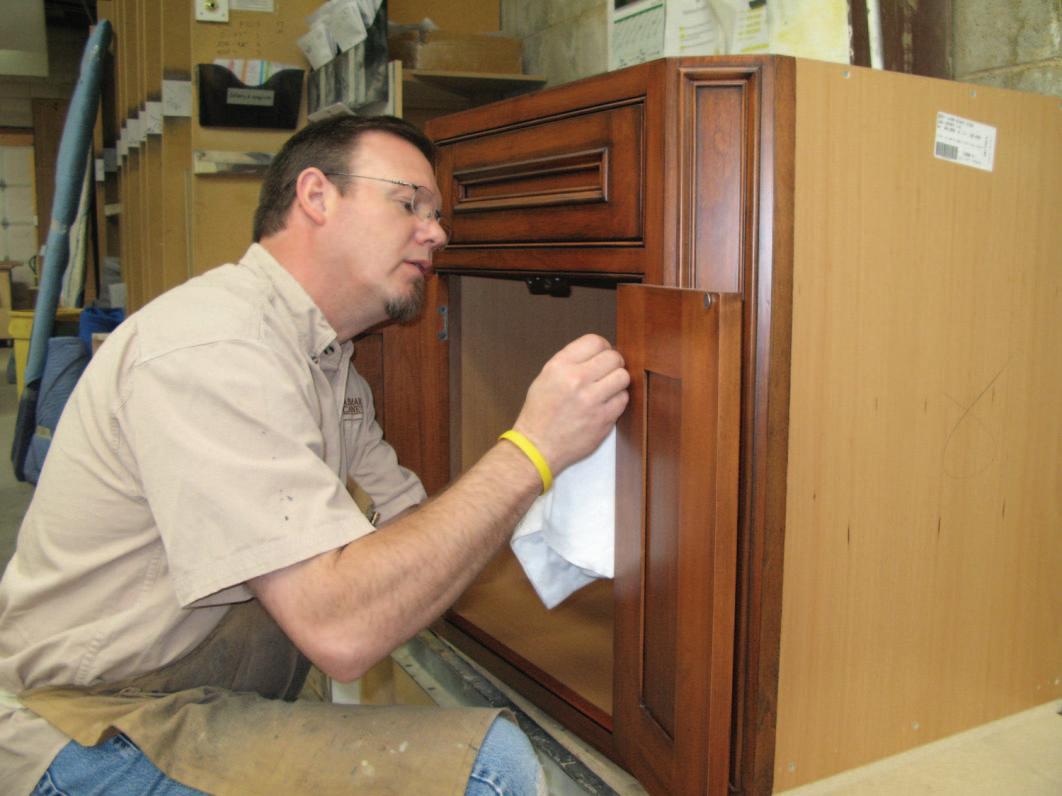
For more than 20 years Hallmark Cabinet (Salt Lake) has been making high-end, custom cabinetry for customers throughout the Western U.S. MEP helped with the design and layout of their new addition. Now more than 30,000 sq. ft of manufacturing space, Hallmark’s 50 employees use the latest computerized equipment and old-style craftsmanship to create exquisite oneof-a-kind cabinetry for homes and offices.
Governor’s Office of Economic Development • Annual Report 2008 55
MANUFACTURING EXTENSION PARTNERSHIP (MEP)
tioned to work with GOED in the state’s economic development initiatives. The MEP is wholly focused on the state’s manufacturing sector and actively seeks out ways to better position itself to help manufacturers across the state. Placing resources throughout the state, modeled after the Ag Extension Services, Manufacturing Agents would have local insight to needs in particular areas and could then draw on the expertise of the MEP Utah Center and its national network of manufacturing experts to meet specific community requirements.
With MEP as its partner, GOED has not lost sight of the overall importance of manufacturing to the state, its large employee base, livable wages, tax contributions, creation of secondary jobs, and a major role in producing most of Utah’s exported goods. MEP will continue to be a resource to the small and medium-sized manufacturers throughout the state and help the entrepreneurial spirit of Utah companies succeed in an ever-changing economy. In both market upturns and downturns, manufacturers face the challenge of differentiating themselves and determining how to bring what is different to the market in a more efficient, costeffective way. As Futura Industries president Sue Johnson stated, “…we could not have made anywhere near the progress we have without MEP’s help and guidance. We are very appreciative to the State of Utah for its support of this program.”
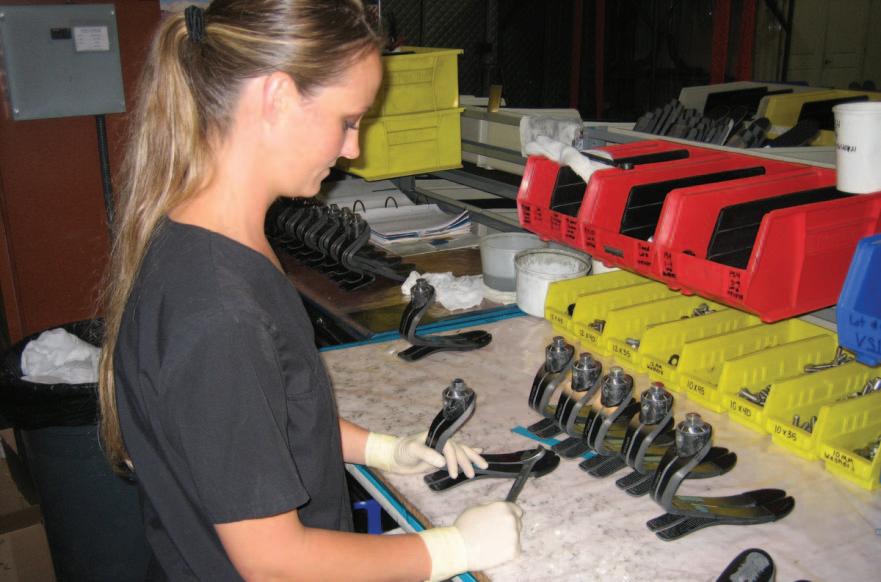
More than turkey production, Sanpete County has become home to several high-tech composite manufacturers. One such is Freedom Innovations. Roland Christensen founded Applied Composite Technology in Fayette, UT in 1984 and it quickly became a premier developer of prosthetic feet and components. Today, as Freedom Innovations, the company’s innovative technologies provide top-quality, high performance prosthetic devices for individuals with lower limb amputations.


Parvus’ RiderNet vehicle Internet access solution provides UTA commuter bus passengers with broadband Wi-Fi access on their way to work. Since 1983, Parvus Corporation (Salt Lake) has been a strategic systems engineering and development partner for aerospace, defense, transportation, and industrial Original Equipment Manufacturers (OEMs).
Governor’s Office of Economic Development • Annual Report 2008 56
UTAH DEFENSE ALLIANCE
The Utah Defense Alliance is proud to be able to continue to partner with GOED in the support of the Defense and Homeland Security Cluster in general and of the country’s military missions, organizations and installations in particular.
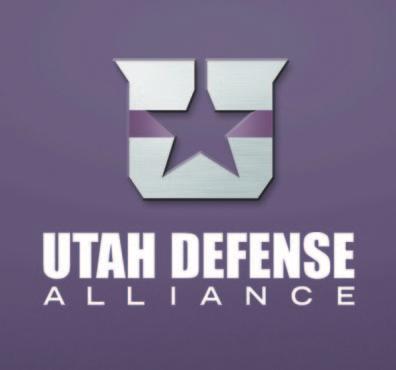
The Utah Defense Alliance (UDA) began in the early 1990’s as a group of volunteer citizens and businesses who came together to ensure the long-term viability of Hill Air Force Base, especially during the military’s Base Closure And Realignment (BRAC) processes. Their hard work, vision and planning resulted in Hill Air Force Base, not only remaining open, but thriving, while other communities across the nation dealt with the impacts of military installations closing or significantly down-sizing.
In early 2006, UDA broadened its efforts to look at all military activities across the entire State, including U.S. Army Dugway Proving Ground, Tooele Army Depot, Deseret Chemical Depot, and all National Guard and Reserve organizations. UDA remains a volunteer board, comprised of board members from local businesses, defense and aerospace industries, concerned citizens, academia, and local, state and federal government, all committed to advocating for the military installations and growing the defense industry in Utah.
The overall mission of UDA is to strengthen and support all appropriate governmental and private enterprises in their accomplishment of national defense objectives and expand investment and employment opportunities in defense and aerospace related industries. To that end, UDA has had a busy year.
UDA is engaged in two contracts with GOED. The first is for UDA Operations. The objectives of this contract are to support UDA ’s overall mission and goals and provide staff support to the Military Installation Development Authority (MIDA). MIDA, created by the State Legislature in 2007, was created to encourage the proper redevelopment of aging and deteriorating infrastructure on any military installation in the State, particularly at Hill Air Force Base (HAFB) through viable Enhanced Use Leasing (EUL) projects. Specifically, MIDA is working to further solidify HAFB as a world class military installation and making Falcon Hill Development, a 550-acre parcel of land along I-15, a world class business park targeting aerospace, composites and defense industries. The MIDA Board includes seven members appointed by the Governor. This past year UDA/MIDA engaged with numerous officials representing local and State government, Hill Air Force Base, Headquarters Department of the Air Force and a proposed private developer for the property, in order to understand the issues for effective development and begin the process to coordinate efforts.
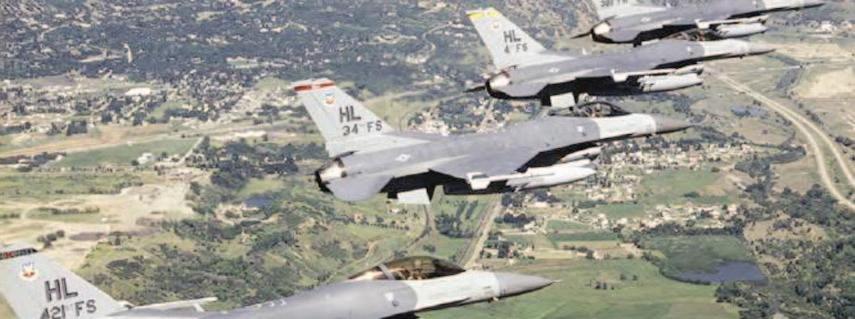
The second contract is to provide Pro curement Services in support of GOED’s Procurement Technical Assistance Center. The objectives of this one million dollar contract is to improve the awareness and success rate of Utah businesses in competing for federal, state and F-16
Governor’s Office of Economic Development • Annual Report 2008 57
fighter jets train over Hill Air Force Base.
UTAH DEFENSE ALLIANCE
local government contracts. UDA (and its sub-contractor Logistics Specialty, Inc., Layton) is under contract with helping Utah businesses prepare bids, be aware of upcoming federal requirements, introducing small contractors w ith large contractors and seeking out worldwide opportunities. Throughout the year, numerous companies have been provided a myriad of assistance as identified by PTAC, resulting in increased success at winning government contracts and growing companies. To help oversee this contract, UDA formed a Procurement Services Sub-committee
review results and program performance.

Governor’s Office of Economic Development • Annual Report 2008 58
that meets quarterly to
F-35 Joint Strike Fighter jet.
WORLD TRADE CENTER UTAH
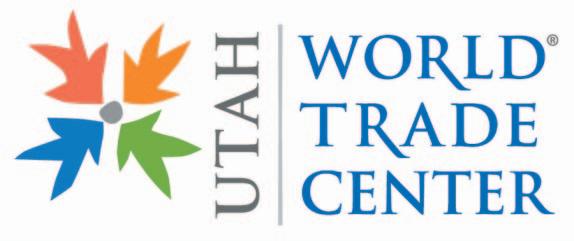
The World Trade Center Utah (WTCU) has been delivering on its bold mission for Utah: to guide Utah companies into global markets. Utah is an ideal catalyst for increased—and profitable—international trade. Utah enjoys the unique cultural, educational, economic and foreign language foundations that the World Trade Center Utah is energizing for expanded global business opportunities.
The WTCU daily brings together private and public sectors by offering, often in conjunction with talented partner agencies, a variety of indispensable resources. Approximately 600 businesses in all parts of Utah were assisted during the 2007/2008 year through a combination of educational classes and seminars, international business development events, and the ongoing generation of networking opportunities. Briefly stated, WTCU is working hard to assess, educate and connect international business in Utah.
Several WTCU accomplishments this year include:
■ Hosting educational seminars such as:
•“Opening New Markets, Expanding Opportunities Through Free Trade; Canada, Colombia, and Beyond”
•Doing Business in South-East Asia, meetings with U.S. trade representatives and legislators on the Free Trade Agreements
■ Sponsoring economic development roundtables
w ith partners:
•The Ambassador for the Republic of Hungary
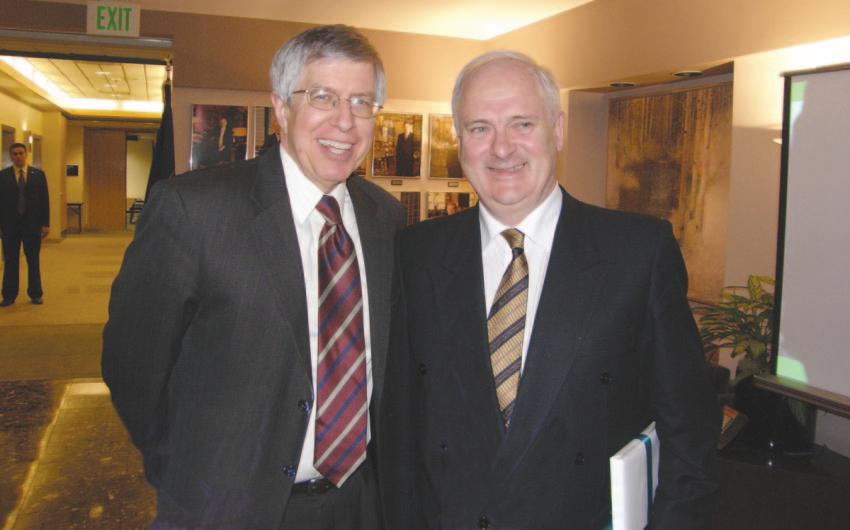
•The Canadian trade delegation, with Eduardo Muñoz, Vice Minister of Foreign Trade, Republic of Colombia;
■ Connecting Utah business with:
•The Ambassadors of Australia, Belgium, European Union, Hungary, Korea, Paraguay, France
•Consular delegations from Peru, Malaysia, France, Japan, Canada, Hungary, Norway, Taipei

With many aspects of trade and export assistance available through WTCU, businesses throughout Utah have the essential tools they need to undertake the most effective globalization of their products and services. In addition, through Utah’s membership in the World Trade Center Association, Utah companies have access to the vast resources of more than 300 other licensed World Trade Centers around the globe.
The WTCU provides a “first stop” location for Utah business men and women to learn, to engage and to prepare for the future of their companies—even more broadly, the WTCU will enhance the future of Utah in an increasingly globalized world.
Governor’s Office of Economic Development • Annual Report 2008 59
Lew Cramer, President & CEO WTC, with John Bruton, Former Irish Prime Minister and current EU Ambassador to the U.S.
Governor Huntsman and Utah leaders greet dignitaries throughout the year.
GOED ORGANIZATIONAL CHART

Governor’s Office of Economic Development • Annual Report 2008 60




























































































